Mexico City, a sprawling metropolis brimming with culture, history, and culinary delights, is a destination that captivates travelers from around the globe. As you plan your adventure to this vibrant capital, one of the first practical questions that might pop into your head is: What Time Is It In Mexico City?
Understanding the time in Mexico City is crucial for planning everything from booking tours and making restaurant reservations to simply knowing when to call home without waking someone up in the middle of the night. This comprehensive guide will not only answer your immediate question but also provide you with all the essential information you need about time in Mexico City, ensuring your trip is smooth and well-organized.
But beyond just the time, Mexico City offers an immersive experience that goes far beyond logistics. Having explored this incredible city over three separate trips, spending almost a month in total, we’ve fallen head over heels for its unique charm. From its efficient public transportation system (a feature many of us wish we had more of back home!) to its world-class food and drink scene, Mexico City is a city that truly has it all.
What struck us most profoundly during our recent visit was the deep cultural and historical tapestry woven into every aspect of city life. We delved into this rich context through a captivating walking tour (the very tour we recommend, which we absolutely loved) and an enriching exploration of the Anthropology Museum, among other cultural experiences.
Grasping how Mexico City transformed from an ancient city nestled on a lake to the vast urban landscape of today gave us a profound appreciation for this extraordinary place. This understanding is why this guide to experiencing 4 days in Mexico City emphasizes experiences that connect you with locals, allowing you to see the city through their eyes.
So, let’s get to the heart of your initial question and then embark on a journey to discover the magic of Mexico City.
Mexico City Time Zone: Central Time
Mexico City operates on Central Time. It’s important to note that Central Time can be either Central Standard Time (CST) during standard time or Central Daylight Time (CDT) during daylight saving time.
Is Mexico City Currently on Daylight Saving Time?
Mexico’s daylight saving time schedule has changed recently. As of 2023, most of Mexico no longer observes daylight saving time, with a few exceptions, primarily in municipalities along the US border. Mexico City does not observe daylight saving time.
Therefore, Mexico City remains on Central Standard Time (CST) year-round.
Finding the Current Time in Mexico City
The easiest way to find out the current time in Mexico City is to simply search “what time is it in mexico city” on Google or any search engine. Numerous websites and online tools also provide real-time clocks for Mexico City.
Time Difference Between Mexico City and Other Major Cities
Understanding the time difference between Mexico City and your location is essential for planning calls and managing schedules. Here’s a quick guide to the time difference between Mexico City (CST) and some major global cities:
- New York (EST/EDT): Mexico City is typically 1 hour behind New York during EST (Eastern Standard Time). However, because Mexico City does not observe DST, during EDT (Eastern Daylight Time), Mexico City is on the same time as New York.
- Los Angeles (PST/PDT): Mexico City is 2 hours ahead of Los Angeles during PST (Pacific Standard Time). During PDT (Pacific Daylight Time), Mexico City is 2 hours ahead.
- London (GMT/BST): Mexico City is typically 6 hours behind London during GMT (Greenwich Mean Time). During BST (British Summer Time), Mexico City is 6 hours behind.
- Paris (CET/CEST): Mexico City is typically 7 hours behind Paris during CET (Central European Time). During CEST (Central European Summer Time), Mexico City is 7 hours behind.
- Tokyo (JST): Mexico City is 14 hours behind Tokyo year-round.
- Sydney (AEDT/AEST): Mexico City is 16 hours behind Sydney during AEDT (Australian Eastern Daylight Time). During AEST (Australian Eastern Standard Time), Mexico City is 16 hours behind.
Practical Implications for Travelers
- Flight Arrivals and Departures: Always double-check your flight tickets and confirmations to ensure you are aware of the time zone for both departure and arrival cities.
- Tour and Reservation Times: Confirm all tour and restaurant reservation times in Mexico City time to avoid any confusion.
- Calling Home: Be mindful of the time difference when calling friends and family back home to avoid calling at inconvenient hours.
- Jet Lag: While the time difference for many North American travelers might not be extreme, be aware of potential jet lag, especially if you are arriving from a significantly different time zone. Give yourself some time to adjust upon arrival.
Now that we’ve clarified the time in Mexico City, let’s dive into the wonders this city has to offer with a detailed 4-day itinerary.
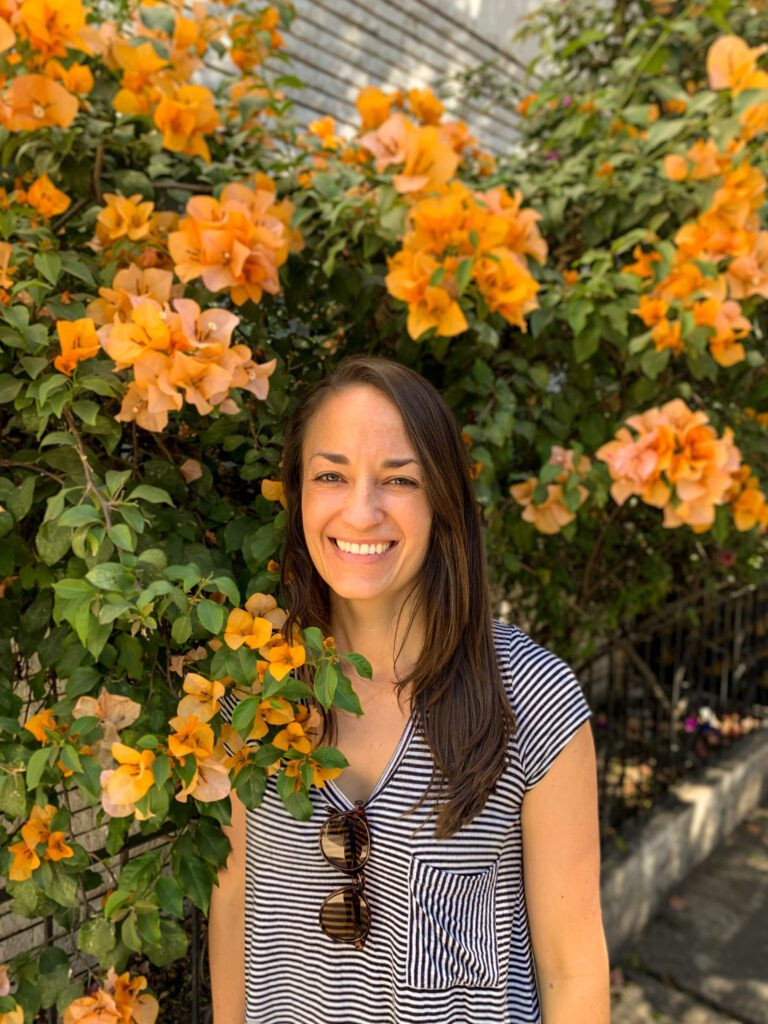 Alysha immersed in the vibrant flower stalls of Mexico City, showcasing the city’s colorful and lively atmosphere.
Alysha immersed in the vibrant flower stalls of Mexico City, showcasing the city’s colorful and lively atmosphere.
Contents
show
1. How Many Days Do You Need in Mexico City?
2. Where to Stay in Mexico City
3. Getting Around Mexico City
4. Is Mexico City Safe?
5. Things to Know Before You Go
6. 4 Days in Mexico City: A Perfect Itinerary for First Timers
1. How Many Days Do You Need in Mexico City?
When planning your trip, remember that Mexico City is ENORMOUS. It’s the most populous city in North America, which translates to an almost limitless array of activities and sights. Trying to cram everything into just four days is simply impossible.
Even after three visits, with two lasting over a week, there are still places in Mexico City on my personal list that remain unexplored.
This itinerary is designed to leverage our experiences and in-depth knowledge of the city to help you prioritize and focus your time effectively.
For a first-time visit to Mexico City, we recommend spending between four and six days.
This guide focuses on a four-day trip, with suggestions for extending your stay in the “with more time” section.
2. Where to Stay in Mexico City
Having stayed in various neighborhoods across Mexico City, including Coyoacán, I strongly believe that for most visitors, especially those on a shorter trip like four days, the best areas to stay are the centrally located trio of Roma Norte, Condesa, or Juarez.
There are compelling reasons for this recommendation.
Firstly, Location is Key. These neighborhoods form a convenient triangle just southeast of Chapultepec Park. Their central position, roughly equidistant from Polanco and the Centro Histórico, ensures you’re never too far from the main attractions.
Secondly, Ambiance and Vibe. Roma Norte and Condesa, in particular, are among Mexico City’s more upscale areas. Expect charming, tree-lined streets and some of the city’s finest dining and nightlife.
Each of these three neighborhoods offers a slightly different flavor. Here’s a brief overview:
P.S. While the Historic Center (Centro Histórico) is a must-visit, we don’t recommend staying there. It can be noisy, overwhelmingly busy, and less relaxing than other options.
For a more detailed exploration of accommodation options, check out our guide to the best places to stay in Mexico City. It breaks down our top four neighborhood picks, outlining the pros and cons of each, along with a curated selection of hotels and guesthouses that offer unique and enjoyable stays.
3. Getting Around Mexico City
Mexico City’s sheer size, being the largest city in North America, significantly impacts transportation. Two major implications for getting around stand out:
First, traffic is notoriously heavy. From roughly 11 am to 7 pm daily, major roads throughout the city become heavily congested. Traveling between neighborhoods during these peak hours (e.g., Centro to Roma Norte, or Condesa to Coyoacán) can take a considerable amount of time.
Therefore, you’ll need to either factor in extra travel time, especially for time-sensitive commitments like tours, or rely on public transportation, which largely bypasses traffic congestion thanks to the underground subway and dedicated bus lanes.
Second, walking between neighborhoods is often impractical. While walking within a neighborhood is enjoyable and recommended, the distances between neighborhoods are often too vast for comfortable walking.
For inter-neighborhood travel, your best options are Uber or public transportation. Each has its advantages and disadvantages, depending on your priorities. Let’s explore them:
Using Public Transportation in Mexico City
Mexico City boasts an extensive public transit network, offering excellent coverage via buses and the metro. You can reach almost any destination for a mere 5-8 pesos.
However, this affordability doesn’t always translate to speed or efficiency.
In my experience, using public transportation often involves transfers, which can be confusing, especially when stations aren’t directly connected, and time-consuming. Additionally, the walk from the station to your final destination can sometimes be lengthy.
Moreover, both the metro and buses are frequently packed, particularly during peak hours, which might not be the most pleasant experience.
The primary advantage of public transportation is bypassing the severe traffic congestion that plagues the city during rush hour (roughly 11 am to 7 pm).
However, these hours also coincide with peak ridership on public transit, meaning crowds are inevitable.
If you have a fixed appointment, like a tour or class, during rush hour, public transportation is advisable to avoid traffic delays.
Using Uber in Mexico City
Uber stands out as the most efficient and safe way to navigate Mexico City, aside from public transit, when traffic is considered.
While taxis are abundant and relatively inexpensive, communication can be challenging if you don’t speak Spanish fluently, and the lack of fixed fares can lead to price gouging.
Uber, with its pre-set fares and destination input, offers greater reliability and transparency. We consistently use Uber whenever walking or public transportation isn’t a timely or convenient option.
4. Is Mexico City Safe?
My mother (Matt here!) always expresses safety concerns whenever we visit Mexico City.
“Keep in touch! Stay together! Be aware of your surroundings!”
While these are generally sound travel tips anywhere, it’s worth noting that such warnings don’t always accompany trips to cities like Paris or Amsterdam, despite similar safety advisory levels to Mexico City according to the US State Department at the time of writing.
Based on our experiences in Mexico City, in the tourist-frequented areas you’re likely to visit on this itinerary, we’ve never felt less safe or more uncomfortable than in many cities within the United States.
Generally, the areas popular with tourists in Mexico City, which is a VAST city, are not the areas with higher safety risks.
However, it’s still prudent to take certain precautions in Mexico City. Here are a few safety tips to keep in mind:
- Leave valuables at home.
- Be vigilant with your belongings in crowded areas and on public transportation.
- Avoid walking alone late at night.
- Opt for Uber over taxis for safer and more reliable transportation.
5. Things to Know Before You Go
Here are some essential things to keep in mind before your Mexico City trip:
Altitude Adjustment is Key. Mexico City sits at a high elevation of 7,350 feet (2,240 meters) above sea level. The altitude is significant, so take it easy on your first day. Drink plenty of water and use sunscreen, as the sun’s intensity is amplified at higher altitudes.
Intense Sun Exposure. Partly due to the elevation, the sun in Mexico City is particularly strong. Sun protection—sunscreen, hats, and long sleeves—is crucial, even on overcast days.
Pack Layers for Temperature Swings. Especially during winter months (November, December, and February), Mexico City experiences dramatic temperature fluctuations. Mornings can be chilly, but temperatures can rise by 30 degrees Fahrenheit (around 17 degrees Celsius) by afternoon. Layering is essential for comfort throughout the day.
Combat Dryness with Chapstick. The high altitude contributes to Mexico City’s very dry climate. Chapstick is a must-have to prevent chapped lips.
Avoid Tap Water. Unfortunately, tap water in Mexico City is not safe to drink. Bottled water is the safest option. Consider buying large jugs of water (5 or 10 liters) to refill a reusable water bottle, reducing plastic waste from numerous small bottles.
Spanish is Helpful, Though English is Spoken. While English is more prevalent in Mexico City, particularly in neighborhoods like Condesa and Roma Norte, than in other parts of Mexico or Latin America, knowing some basic Spanish phrases will be incredibly useful and appreciated by locals (“Chilangos”). Learn phrases like hello, please, thank you, and “Do you speak English?”.
Rainy Season is Significant. Like many equatorial regions, Mexico City has a distinct rainy season, typically from June to October (summer months). During this period, expect daily downpours, often starting around 3 pm and lasting for a few hours, or sometimes just minutes, depending on the day. We prefer visiting Mexico City during the dry season (winter for North Americans and Europeans) when the abundant sunshine provides a welcome escape from persistent gray skies.
6. 4 Days in Mexico City: A Perfect Itinerary for First Timers
Now, let’s get into the heart of your Mexico City adventure with a detailed 4-day itinerary.
We’ve learned a valuable travel lesson over years of exploration, particularly during a three-month European trip:
Travel becomes richer, more rewarding, and significantly more enjoyable when you strive to connect with locals and experience a place through their eyes.
We’ve embraced this philosophy in Mexico City, participating in numerous tours and local experiences that have unveiled new facets of the city, its culture, and its people.
Our top tip for Mexico City is to prioritize guided tours, a recurring theme in this itinerary.
Structurally, we build each day around a central experience, with time allocated before and after for coffee, cocktails, and simply wandering and absorbing the neighborhood vibes.
Day 1: Introduction and the Centro Histórico
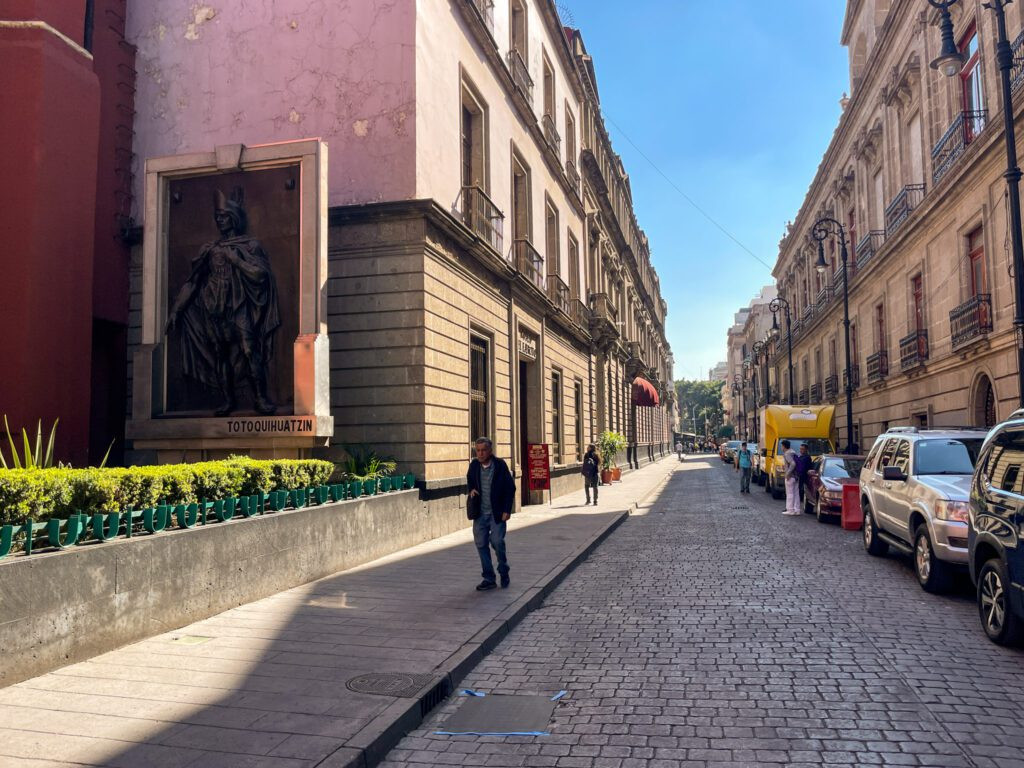 A vibrant street scene in the Centro Histórico of Mexico City, capturing the historical architecture and bustling city life.
A vibrant street scene in the Centro Histórico of Mexico City, capturing the historical architecture and bustling city life.
Your first day in Mexico City should begin in the historic heart of the city, the Centro Histórico.
This area marks the original site of Tenochtitlan, the Aztec capital. The Aztecs, we learned, migrated from the north and, after centuries of wandering, settled in the valley where Mexico City now stands.
Mexico City, surprisingly, is built upon a lakebed (or swamp, depending on perspective). Centuries ago, it resembled Amsterdam with its network of canals, a stark contrast to today’s sprawling urban landscape.
Over the past century, most of these canals have been filled in. However, remnants of the canal system persist south of the city in Xochimilco, a crucial piece of Mexico City’s history that we’ll explore on Day 4.
This urban development has created a significant challenge: as groundwater is pumped out, the city is sinking, particularly the denser areas like the Centro Histórico, Roma, and Condesa, weighed down by large buildings and dense populations.
Before we delve deeper, let’s play a quick game.
How many inches per year do you think the historic center of Mexico City is sinking on average?
When we posed this question to friends and family, answers ranged from half an inch to a bold five inches.
The actual figure is a staggering 20 inches per year, nearly two feet! This is a remarkable and concerning rate of subsidence.
The prediction is that Mexico City will eventually face significant structural challenges, possibly within 25-50 years.
Despite these challenges, the Centro Histórico in its current form is an absolute must-see.
Having spent roughly three days exploring the historic center, we’ve concluded that the best approach is to begin with a guided tour, followed by independent exploration of other points of interest. This is the structure we’ve adopted for your first day.
A Guided Walking Tour of the Centro Histórico
Over the past few years, we’ve realized that walking tours are often the ideal way to get acquainted with a new city. They offer several key advantages:
Firstly, you receive a condensed history and culture lesson, providing a valuable foundation that enhances your entire trip.
Secondly, you spend a few hours with a local guide who can offer insider tips on the best places to eat, drink, and explore, including hidden gems you might otherwise miss.
Lastly, and especially evident in Mexico City where I had previously attempted a self-guided tour and missed 90% of the hidden gems, you discover places you would never find on your own.
For instance, inside the building adorned with Azulejos tiles in the Centro Histórico, there’s an upstairs room filled with historical photographs of Mexican Independence fighters, including Pancho Villa pictured at the bar within the same building – a truly fascinating find.
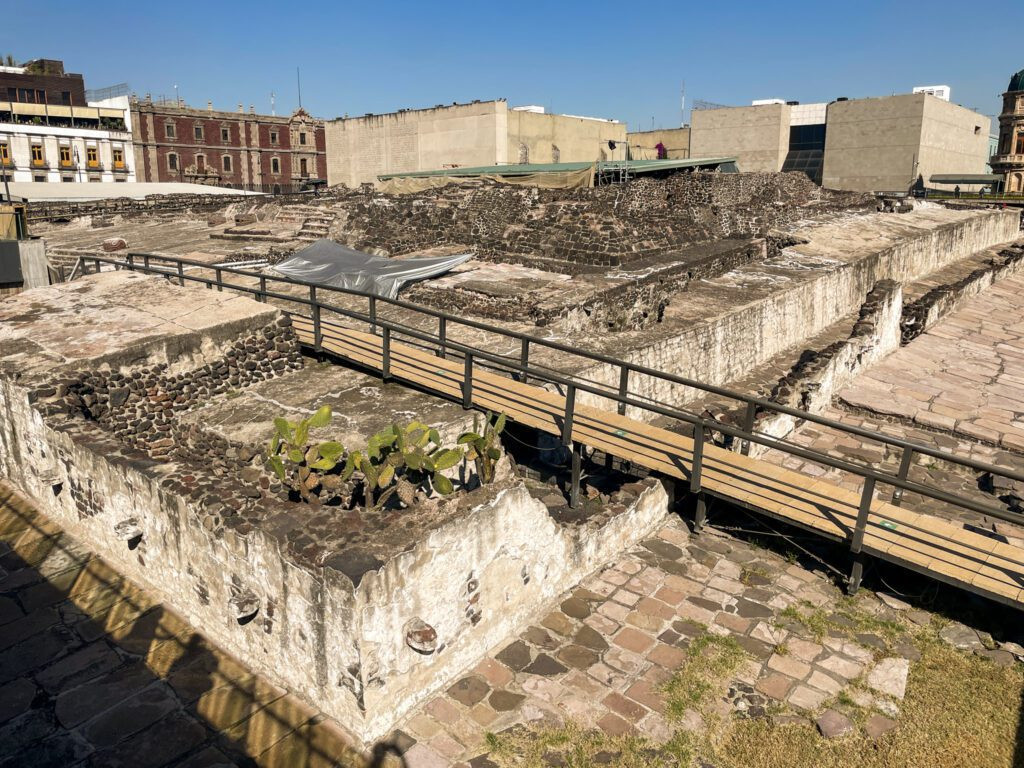 Ruins of Templo Mayor in Mexico City, showcasing the ancient Aztec history within the modern city.
Ruins of Templo Mayor in Mexico City, showcasing the ancient Aztec history within the modern city.
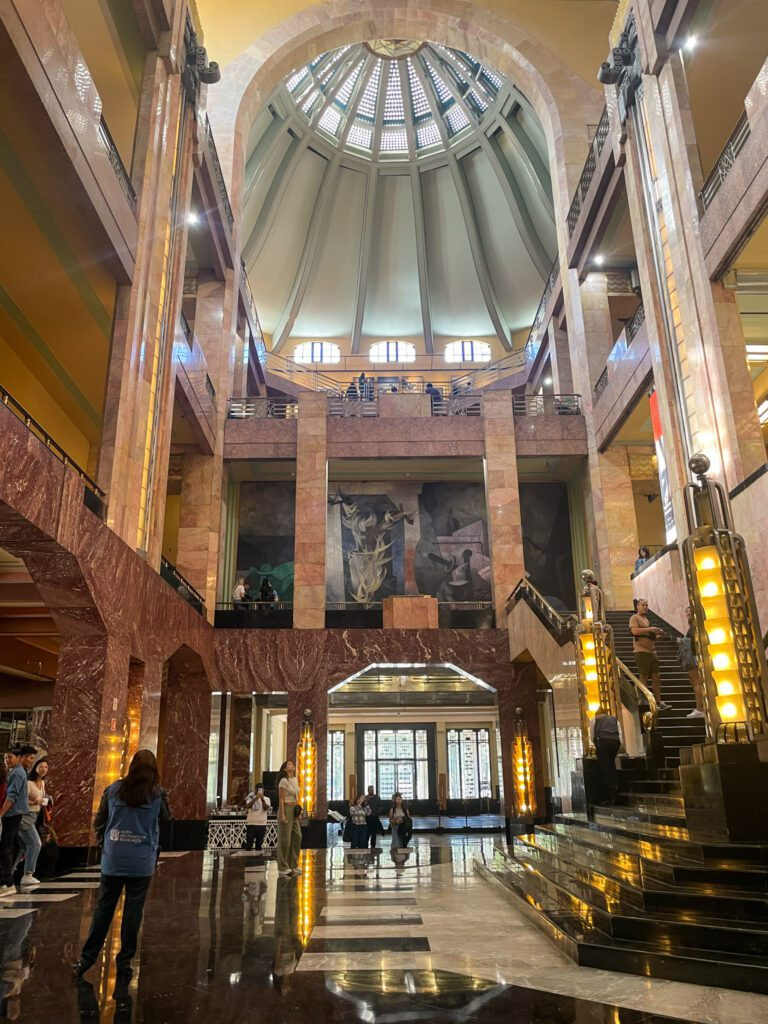 The ornate interior of Palacio de Bellas Artes, highlighting the architectural grandeur and cultural significance of the building.
The ornate interior of Palacio de Bellas Artes, highlighting the architectural grandeur and cultural significance of the building.
Without a guide, we would have undoubtedly missed this and countless other details.
Therefore, if you want to truly understand the Centro Histórico of Mexico City, the site of the ancient Aztec city of Tenochtitlan, a guided walking tour is essential.
Based on our exceptional experience with Mariel, an anthropology student and Mexico City native, we wholeheartedly recommend spending a few hours exploring with her.
We opted for this private tour due to our group size and my positive experiences with With Locals, a platform connecting travelers with local guides worldwide.
The tour covers key landmarks in the center, including the Palacio de Bellas Artes, the Zocalo, and the Metropolitan Cathedral, among others.
It also ventures into lesser-known spots, such as hidden palaces, the incredibly ornate post office, and the exterior of Templo Mayor, the central Aztec temple.
The best aspect, in our opinion, is the ability to choose your local guide. We selected Mariel for her vibrant energy, local roots, and anthropology background.
Our entire group agreed that it was a highlight of our trip.
Click here to check prices and availability for the walking tour we took (and be sure to choose Mariel!).
Tacos al Pastor and Pulque
After your tour, you’ll likely be hungry. Fortunately, several fantastic taco spots are within a short walk, well worth your time.
We discovered these gems on a street food tour during our first Mexico City trip years ago and revisited them on our latest trip.
El Huequito tied for our favorite tacos al pastor in Mexico City. It’s worth noting that the Centro location was noticeably better than another location we tried.
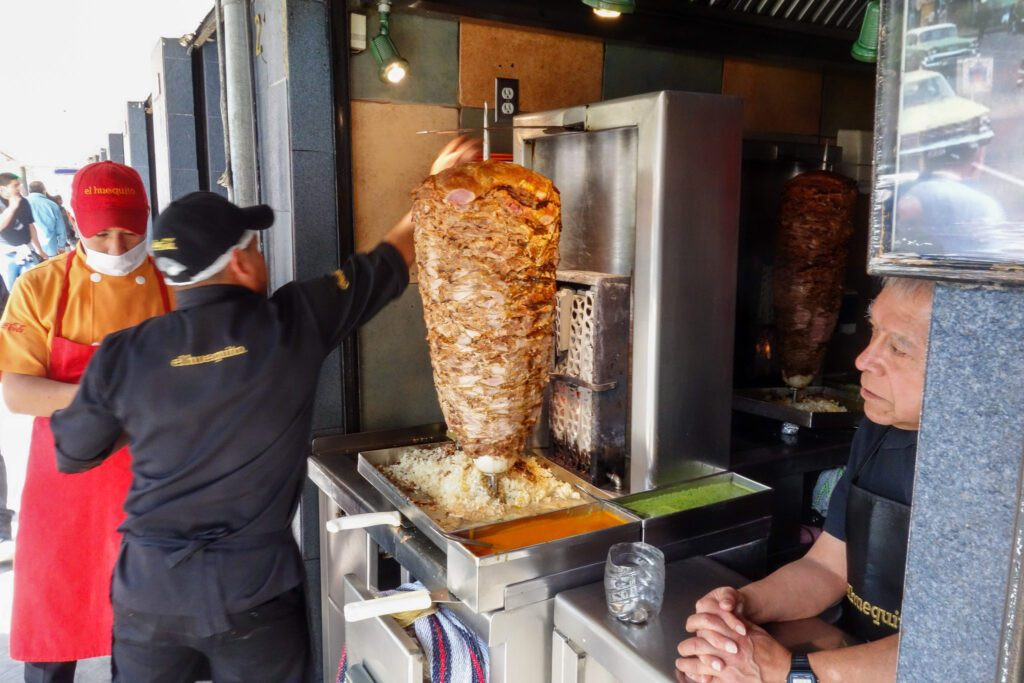 A Taquero at El Huequito expertly preparing Tacos al Pastor, showcasing the traditional cooking method and delicious street food.
A Taquero at El Huequito expertly preparing Tacos al Pastor, showcasing the traditional cooking method and delicious street food.
Our preferred way to enjoy tacos al pastor is not waiting for a table inside but eating them standing at the counter.
Simply approach the taquero (the meat specialist) and tell them how many tacos you want and your desired toppings. “Con todo” (with everything) means onions and cilantro, which is highly recommended.
Then, head to the counter where you’ll find a variety of salsas and lime wedges. Don’t be shy with the lime; a full wedge’s juice per taco is ideal.
After tacos, it’s time for an experience that was both a highlight and slightly stressful: pulque tasting.
Looking at Google Maps after our taco feast, I noticed a pulqueria right across from El Huequito with excellent reviews.
My brothers had expressed interest in pulque, and we decided this was the perfect opportunity!
What exactly is pulque?
Pulque is essentially fermented agave juice, often back-sweetened with fruit juice for flavoring.
It’s similar to kombucha in that it’s low in alcohol (1-4%), but it has a thick, viscous texture, somewhat like nopales (cactus) when cut.
For more in-depth information on pulque, I recommend this Serious Eats article.
The pulqueria we stumbled upon turned out to be Las Duelistas, arguably the most famous pulqueria in Mexico (mentioned in the Serious Eats piece).
Pulque is traditionally enjoyed as an after-work social drink, and we arrived around 5 pm to a completely packed house.
It was so crowded we had to squeeze into a shared table, and I was too concerned about bumping into my neighbor or spilling my drink to take any photos.
I was surprised by the diverse age range of the crowd, from young couples whispering to each other to older men enthusiastically singing along to a ballad on the jukebox.
Managing to decipher the server’s lip movements, we ordered three glasses of pulque: two guava (my favorite flavor) and one cucumber-lime with a Tajín rim, recommended by the server.
Guava remains my top pick, but they offer a rotating selection of five or six flavors. I suggest trying the guava first, then asking the server “cual es tu favorito?” (what’s your favorite?) and trying their recommendation.
Torre Latinoamericana
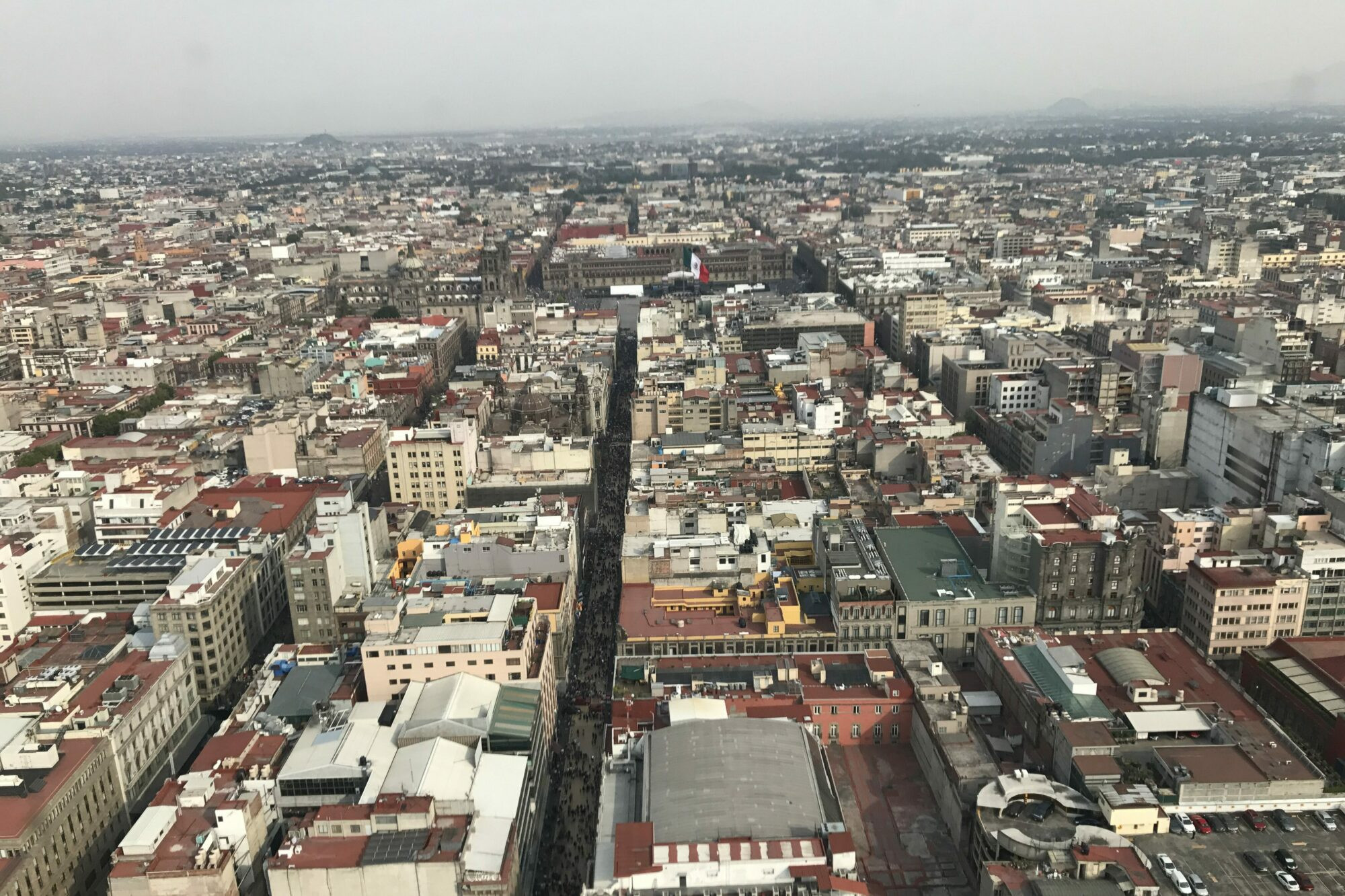 Breathtaking panoramic view of Mexico City from the Torre Latinoamericana, showcasing the vast urban sprawl.
Breathtaking panoramic view of Mexico City from the Torre Latinoamericana, showcasing the vast urban sprawl.
For the best panoramic view of Mexico City and the valley it occupies (allowing you to imagine its lake-filled past), ascend to the top of Torre Latinoamericana, Mexico City’s first skyscraper.
You might wonder, as we did, who conceived the idea of building a skyscraper on a swamp in an earthquake-prone zone.
…We’re not entirely sure (it was commissioned by an insurance company), but it has withstood numerous major earthquakes (though it is gradually sinking).
Their website (we didn’t visit on this trip but did years ago) indicates that foreign cards are not accepted for advance ticket purchases. You must either buy tickets on-site (lines can be LONG, especially on weekends) or through a third-party (linked on their website).
However, even with third-party purchases, you still have to queue to exchange the voucher for a ticket, negating any time-saving benefit.
Therefore, buying tickets upon arrival is generally the best approach. Just request tickets for the “mirador” (viewpoint), not any museums. More information here.
Alternatively, if the line is long (which it often is), skip the mirador and have a drink at the bar (Miralto) near the top of the skyscraper.
The cost per drink is comparable to the mirador ticket price, and you completely bypass the line, taking the elevator directly to the 40th floor.
Choose Your Own (Mezcal) Adventure
To conclude your first day, we offer a choice, reminiscent of the “choose-your-own-adventure” books many of us enjoyed as kids.
For context, I have fond memories of trying mezcal in Mexico City on my first trip and realizing its incredible diversity. Coming from the US, I had always associated mezcal solely with smokiness.
However, that first trip revealed mezcal’s spectrum of flavors: bright and citrusy, fruity, even floral. Yes, it can be smoky, but it’s a vast and varied spirit.
On a subsequent trip, I decided to delve deeper, participating in a guided tasting of different mezcal varieties.
Of all the tours and experiences mentioned, this one is perhaps the most optional, hence the two choices: the guided tasting we did, and a DIY version exploring our favorite mezcal spots in Roma Norte.
Your choice depends on your budget and interest level.
Regardless, I highly recommend dedicating a couple of hours to exploring different types of mezcal, especially if you’ve primarily experienced the smoky versions common in the US.
A Guided Mezcal Tasting
This is the guided mezcal tasting we enjoyed. We spent a couple of hours in a small group in Roma Norte, sampling five distinct mezcal varieties in an intimate setting.
The session began with an overview of mezcal—its origins, production methods, and regional variations—followed by tastings of five mezcals, learning about each variety’s unique characteristics. We even received a bonus tasting of a particularly special mezcal at the end.
Even if you’re not a regular straight liquor drinker, this experience was fantastic. While it’s not inexpensive at $60 per person, the value lies in the expert guidance and curated selection of mezcals, allowing you to discern the nuances between varieties.
Pro-tip: Eat a substantial meal beforehand. Five mezcal tastings (even if you “kiss” and savor them, not take them as shots) is a significant amount of alcohol. In our older age, it might have been overwhelming, but thankfully we did this experience in our younger days.
DIY Mezcal Tour
For a DIY approach, focus on three bars in Roma Norte we’ve enjoyed, all within a 10-minute walk of each other, presented in our recommended tasting order:
La Clandestina**: Our original recommendation, visited on three separate trips. It’s not a curated experience, but their menu is EXTENSIVE, ranging from mild Espadins to bolder varieties from Jalisco (unlike Oaxaca, the primary mezcal region). They also offer a Kiwi Mezcal cocktail, one of the best cocktails I’ve ever had in Mexico City.
Mano Santa**: Another Roma Norte mezcaleria, similarly intimate to La Clandestina, with sidewalk seating. They have a wide selection, including varied types and intriguing experimental processes, plus a food menu featuring Oaxacan cuisine (try the tlayuda).
Mis Mescales: Previously my top recommendation for buying mezcal to take home. Excellent selection, friendly and helpful owner, and conveniently located in Roma Norte. Imagine my disappointment when, while compiling this guide at the Mexico City airport, I discovered they now offer GUIDED TASTINGS, which I missed! For about $20 USD, you can enjoy four mezcal tastings in their cozy space near Mercado Roma. More information here.
Day 2: Chapultepec Park, the National Museum of Anthropology, and Polanco
Your second day in Mexico City is dedicated to a historical journey spanning millennia, from the Mayans and Aztecs to modern Mexico.
This learning will be bookended by coffee in La Condesa, a stroll in Mexico City’s version of Central Park, and an evening in Polanco, the city’s most glamorous neighborhood.
IMPORTANT: These museums are closed on Mondays. If Day 2 falls on a Monday, swap it with another day!
But First, Coffee in La Condesa
Before the day’s explorations begin, you’ll need caffeine to fuel your museum visits.
Fortunately, the northwest corner of La Condesa, near your first park stop, is a haven for excellent coffee.
Here are three top coffee options to start your day:
Camino a Comala: Recommended by Christian, our coffee experience guide, and it didn’t disappoint.
They served me what I consider the best cup (tied for best) of coffee in Mexico City – a gesha from the renowned Finca Chelín in Oaxaca – bursting with floral notes in both aroma and taste.
They also offer other, more affordable pour-over coffees and a range of espresso drinks.
Anvil Café: A tiny space, similar in size to many tortillerias in Mexico City. It’s worth a visit for their horchata espresso alone, which I spotted on the menu and immediately texted my brother to join me and try (spoiler: it was fantastic).
I engaged the barista in (somewhat competent) Spanish about their brewing methods, and he was incredibly helpful and friendly, explaining his pour-over technique.
Limited sidewalk seating and only three bar stools inside.
Blend Station: My feelings about Blend Station are mixed. Positives first: their La Condesa location is stunning. It appears as a typical espresso bar at the entrance but opens into a large, beautiful atrium towards the back. If I had to choose a coffee shop to simply relax in, it would likely be this one.
However, I wasn’t overly impressed with their coffee itself. It was about a 50% hit rate – I loved one of two coffees I had there, and when we bought two bags to take home, I liked one of those two as well.
On a later visit, I tried their espresso tonic, which was actually delightful. Pros and cons, I suppose.
Chapultepec Park, Chapultepec Castle, and the National History Museum
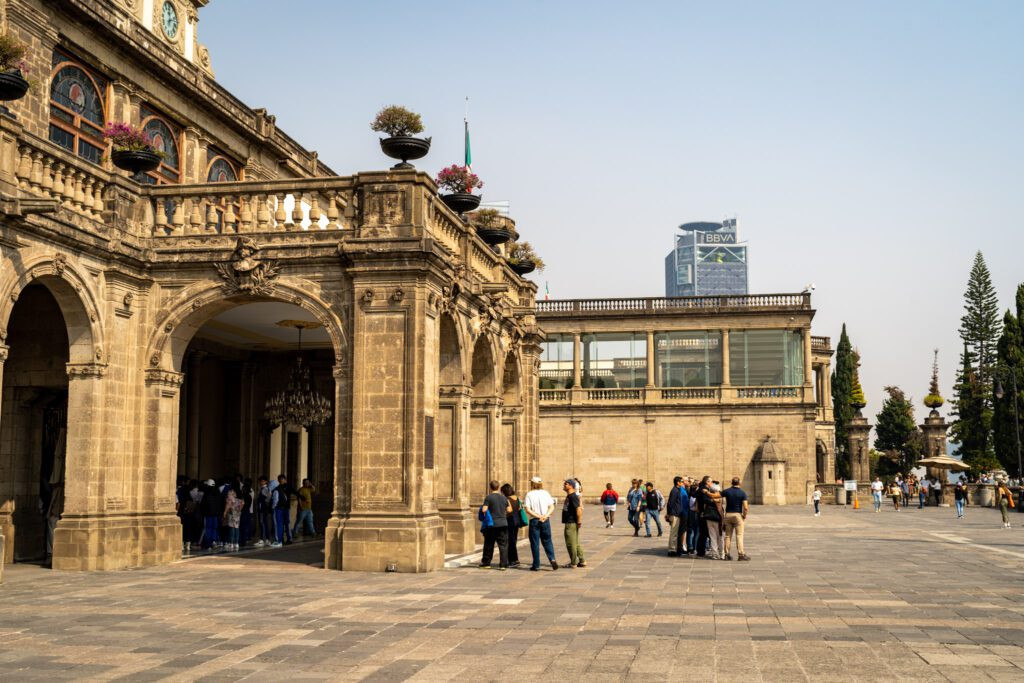 Chapultepec Castle perched atop Chapultepec Hill in Mexico City, offering historical significance and city views.
Chapultepec Castle perched atop Chapultepec Hill in Mexico City, offering historical significance and city views.
Chapultepec Park and Castle were a fantastic discovery on our latest 2023 trip. I’m surprised we hadn’t visited on previous trips.
It has everything we enjoy: great city views, a history lesson (though primarily in Spanish), and beautiful murals.
Chapultepec Castle sits in the heart of Chapultepec Park, atop a hill offering panoramic city views (when smog levels permit visibility to Polanco).
Originally built in the late 18th century as a palace, its stunning views are no surprise.
Over the years, it has served as a palace, military academy, and, most recently, a museum, among other roles.
Today, it houses the Museo Nacional de Historia, the National History Museum.
While the Anthropology Museum will showcase pre-Mexico state history, the National History Museum tells the story of Mexico from its Spanish colonial beginnings to the present day.
Organized largely chronologically, the museum’s highlight for me is the collection of vast murals depicting key historical events: the War of Independence (from Spain), the Revolution (against Porfirio Díaz’s dictatorship), and the Mexican-American War (where US forces captured the castle with heavy casualties).
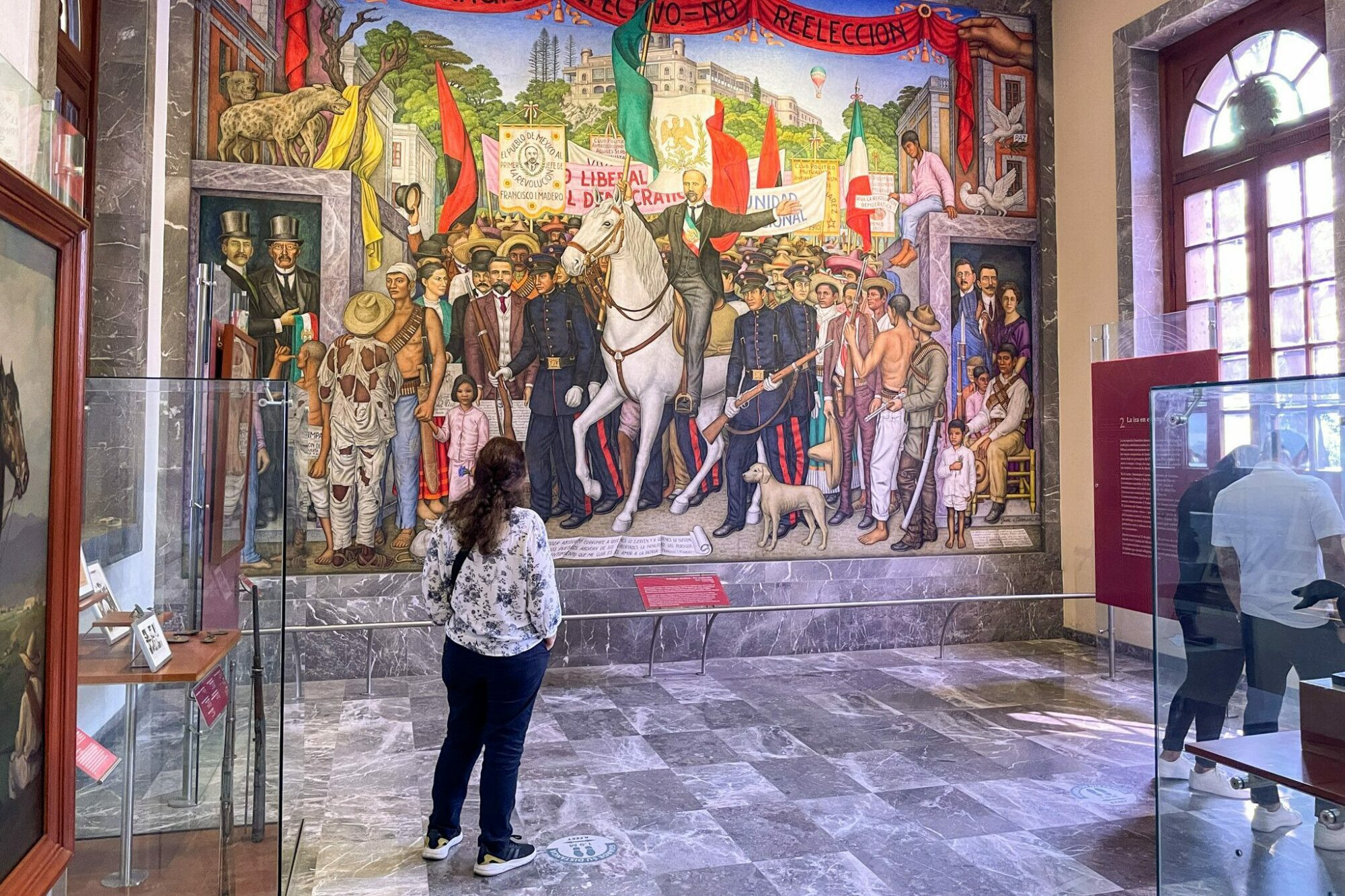 A large mural celebrating the Mexican Revolution within the National Museum of History, illustrating Mexico’s rich historical narrative.
A large mural celebrating the Mexican Revolution within the National Museum of History, illustrating Mexico’s rich historical narrative.
Plan for about 60-90 minutes to explore the museum, including the historical exhibits and enjoying the views.
Exhibits are primarily in Spanish, but even without Spanish fluency, the visual elements are compelling and worthwhile.
Tickets can be purchased on-site for 90 pesos (at the time of writing). Find the most current information on hours, prices, and more here.
Important Note: Bags larger than a small backpack (size definition unclear) and any food or drinks are not permitted inside. Bag check is available, but YOU NEED TO PURCHASE A 10 PESO TOKEN FROM THE TAQUILLA (TICKET OFFICE) FOR BAG CHECK.
El Museo Nacional de Antropología
Of all the recommendations in this itinerary, we are most confident in our opinion about the Museo Nacional de Antropología—which we’ll refer to as “the Anthropology Museum” henceforth.
The Anthropology Museum is a highly prestigious museum in Mexico City, and rightfully so.
It spans millennia of history, housing invaluable artifacts that tell the story of Mexico, with a strong emphasis on its indigenous peoples and their enduring heritage.
While we learned about the Mayans and Aztecs in US schools, it was often limited to brief paragraphs, insufficient for two of the most significant civilizations in the Americas.
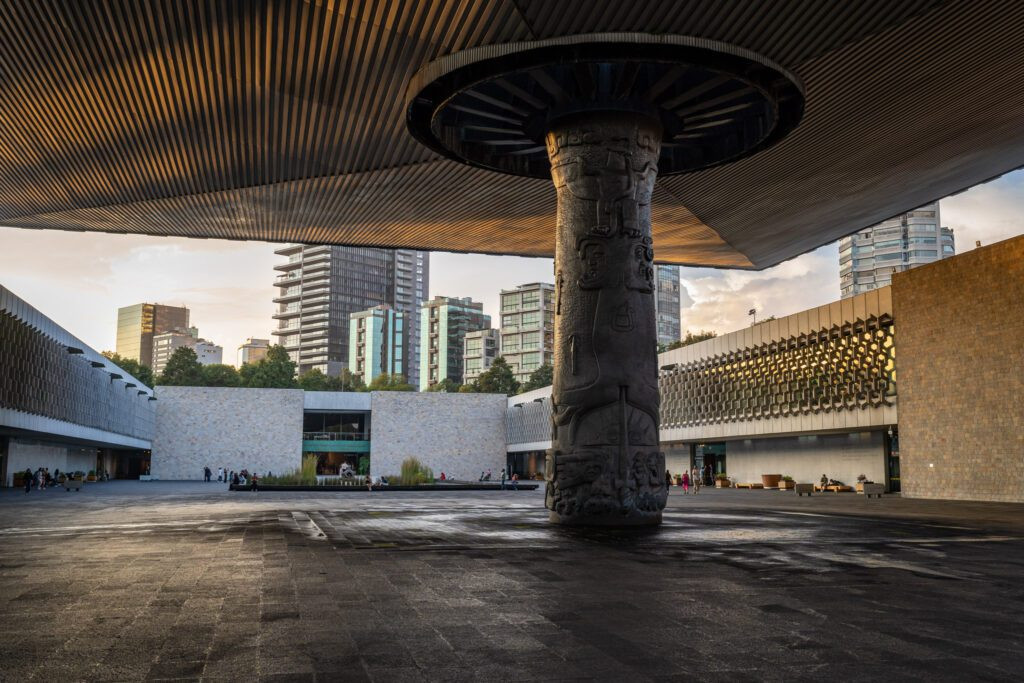 The fountain at the Anthropology Museum in Mexico City bathed in golden hour light, showcasing the museum’s impressive architecture.
The fountain at the Anthropology Museum in Mexico City bathed in golden hour light, showcasing the museum’s impressive architecture.
Let’s briefly discuss our museum philosophy, harking back to our first Mexico City trip in 2017.
Back then, we were relatively inexperienced travelers, and my Spanish was minimal (both have since changed).
We visited the Anthropology Museum at opening time, learning a key lesson: we’re not naturally adept at museums.
This has been confirmed at museums worldwide. We’ve discovered that to truly grasp what we’re seeing, we need a knowledgeable guide to narrate the story.
Otherwise, we tend to wander, uttering phrases like “oh, that’s pretty” and “oh, cool, a snake.”
Here’s our firm recommendation: If your budget allows (it’s not excessively expensive), experience the Anthropology Museum only with a guide.
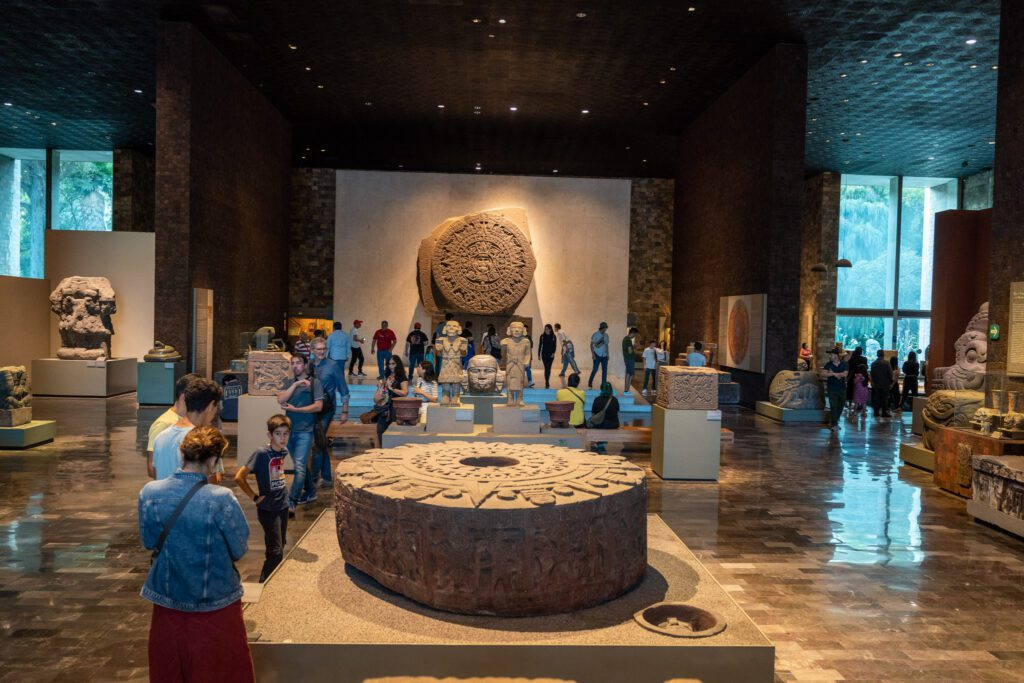 The iconic Aztec sun stone on display at the Anthropology Museum in Mexico City, a key artifact of Aztec civilization.
The iconic Aztec sun stone on display at the Anthropology Museum in Mexico City, a key artifact of Aztec civilization.
There are several reasons, but two are particularly crucial.
Firstly, the museum is IMMENSE, with 22 rooms filled with priceless artifacts spanning thousands of years. Seeing it all would take more than a day. How do you know what to prioritize? A guide is invaluable here!
Secondly, almost all signage is in Spanish (with limited English summaries per room, primarily providing broad historical context, with very few explanations for specific artifacts).
Despite our comfort with Spanish after months in Mexico, Spain, and Colombia, we still found some signage challenging to understand due to specialized vocabulary.
Visiting the Anthropology Museum on a Guided Tour
We took this tour with Carlos, another highlight of our trip.
We spent three hours with Carlos, concentrating on the Maya, Aztec, and Teotihuacan rooms. He skillfully weaved a narrative connecting these civilizations, enriching our understanding in ways we couldn’t have achieved on our own.
One fascinating fact I learned was the reason for the difference in condition between Mayan and Aztec ruins. Mayan ruins often appear more weathered, while Aztec ruins seem remarkably well-preserved.
Mayans primarily used limestone, which is more susceptible to erosion, whereas Aztecs used basalt, a more durable material.
The Anthropology Museum is undoubtedly worth visiting, especially when paired with the nearby National History Museum. However, its size and language barriers make it challenging to navigate independently.
Therefore, a guided tour is highly recommended to maximize your experience.
Click here to check prices and availability for the Anthropology Museum tour we took, which is worth every peso and includes museum entry.
Doing the Anthropology Museum on Your Own
If you choose to explore independently, an English audio guide is essential.
Also, consider your visiting time. We’ve been in both the morning and late afternoon and preferred the late afternoon (when our tour took place) as it’s significantly less crowded, especially with school groups that tend to visit in the mornings.
If possible, visit in the afternoon, a few hours before closing (as structured in this itinerary).
We recommend buying tickets in advance (once you’re in Mexico City is usually sufficient), which you can do here (the “buy tickets” button is in the top bar, and you can switch the website to English using the “ES/EN” toggle at the top).
Important Note: Similar to the National History Museum, bags larger than a small backpack and food/drinks are not allowed. Bag check is free and safe, but the line can be LONG. Avoid bringing large bags if possible.
Feast in Polanco
Polanco is Mexico City’s showcase of affluence and style.
Located north of Bosque de Chapultepec, it’s filled with upscale boutiques, fine dining restaurants (including two of the world’s top 15), and chic bars.
Spending an evening in Polanco is worthwhile, especially if you appreciate fine dining.
We have three specific recommendations in Polanco, though there’s much more to explore, eat, and drink (particularly the modern art at Museo Soumaya if you have extra time).
Firstly, for fine dining enthusiasts, this is your moment.
Two of Mexico City’s most acclaimed restaurants are within blocks of each other in Polanco.
If you’ve watched food shows about Mexico City on Netflix, you’re likely familiar with Enrique Olvera, whose culinary empire spans from Mexico City to New York City. His flagship restaurant, Pujol, is widely celebrated.
The other is Quintonil, whose chef trained under Olvera before venturing out on his own. We’ve experienced both, and they offer distinct experiences.
Pujol is more traditional and refined.
Quintonil is more adventurous and, arguably, flamboyant.
Reservations at either are challenging to secure (book months in advance), but if forced to choose, we’d recommend Quintonil for its innovative take on Mexican cuisine.
 A birthday dinner celebration at Pujol, showcasing the elegant dining experience and culinary artistry.
A birthday dinner celebration at Pujol, showcasing the elegant dining experience and culinary artistry.
One of the 13 courses at Quintonil, highlighting the restaurant’s innovative and visually stunning approach to Mexican cuisine.
Secondly, Limantour lives up to its reputation. This cocktail bar consistently ranks among “the world’s 50 best bars.” While we can’t definitively confirm that ranking, we can attest to consistently enjoying their drinks over multiple visits.
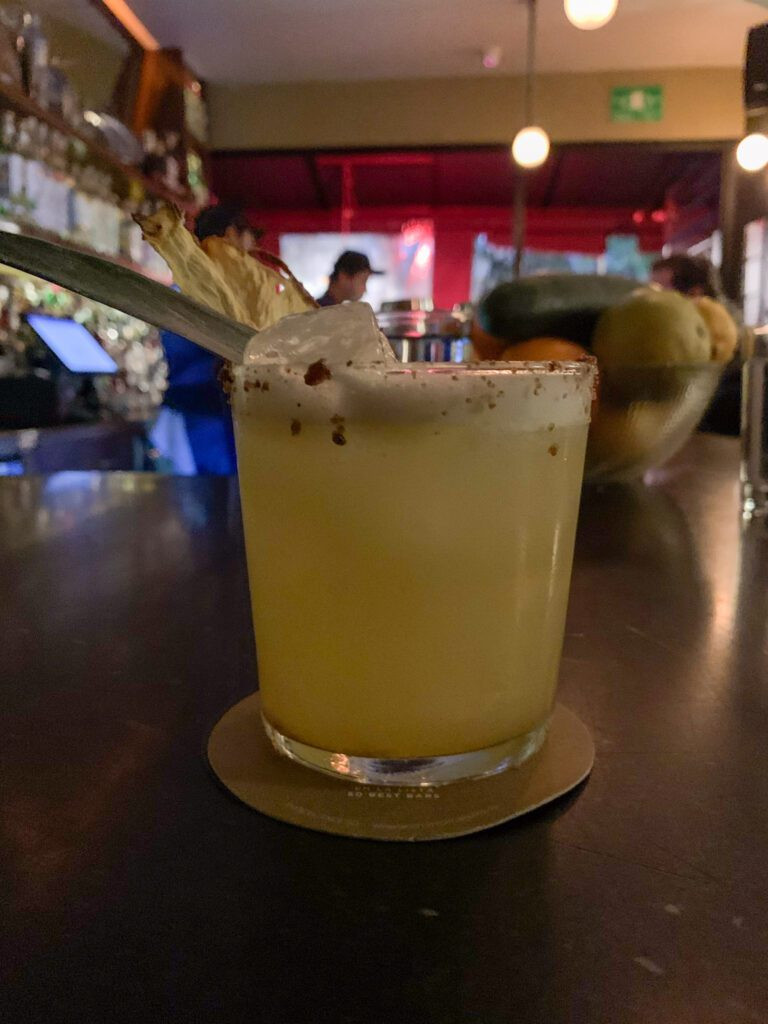 Artfully crafted cocktails at Limantour in Mexico City, showcasing the bar’s reputation for innovative drinks.
Artfully crafted cocktails at Limantour in Mexico City, showcasing the bar’s reputation for innovative drinks.
Thirdly, wander and window shop. Polanco is a premier shopping destination, offering everything from high-end boutiques to local crafts.
Start at Pasaje Polanco (here on Google Maps), which features a curated selection of shops, and explore the surrounding neighborhood from there.
Day 3: A Cooking Class, Roma Norte, and La Condesa
Day three is dedicated to Mexican culinary culture. Spend your morning immersed in a cooking class that includes a market tour in Roma Norte.
After your food coma subsides, explore Roma Norte further before ending your day in the leafy streets of La Condesa.
A Cooking Class + Market Tour at Aura Cocina
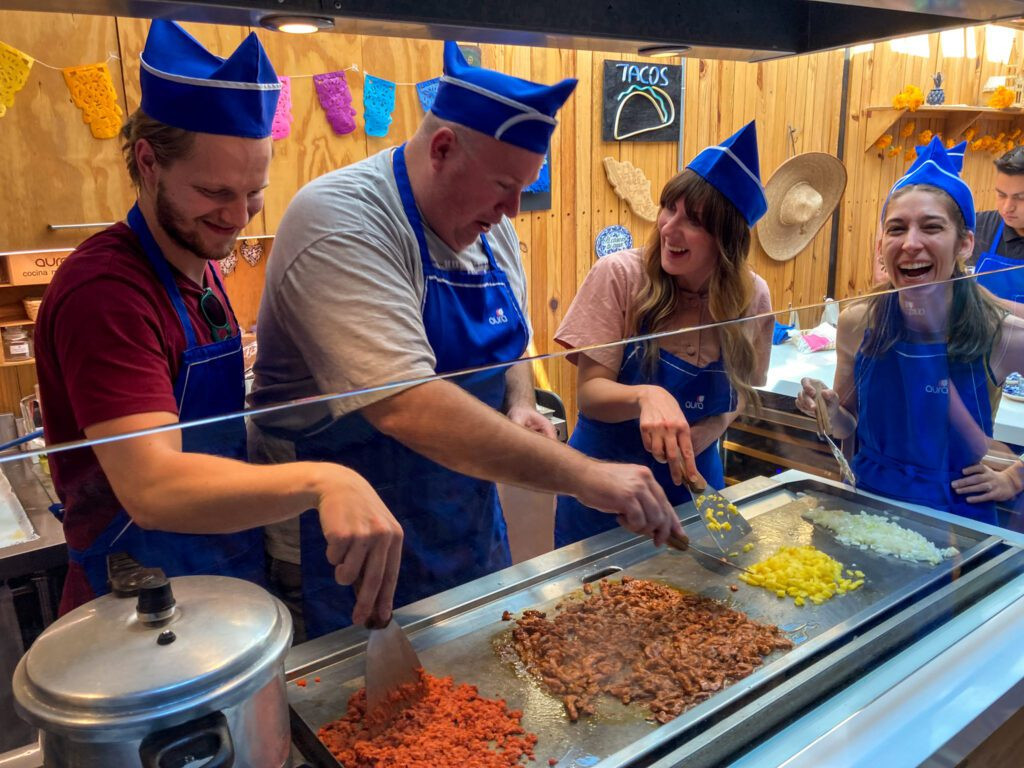 Participants engaging in a hands-on cooking class in Mexico City, learning to prepare traditional Mexican dishes.
Participants engaging in a hands-on cooking class in Mexico City, learning to prepare traditional Mexican dishes.
We’ve already extolled the virtues of museum tours. What else do we love doing while traveling? Cooking classes (and food tours).
Cooking classes and food tours are our favorite ways to deeply explore a destination’s food culture, and they often provide a valuable souvenir: recipes to recreate at home!
As I write this in Portland, I’m preparing a taco recipe from a Mexico City cooking class I took a few weeks ago.
Having experienced both cooking classes and street food tours in Mexico City, I’d choose a cooking class if I had to pick just one (though street food tours are first on our “more time” list).
We especially value classes that include market tours. Like museums, markets can be overwhelming without local guidance to provide cultural context.
Otherwise, we might wander around, admiring unfamiliar produce without truly understanding its significance.
I, Matt, have now taken two cooking classes at Aura Cocina, a cooking studio in Roma Norte, and thoroughly enjoyed both. I consider it a crucial part of any Mexico City itinerary.
Serendipitously, both classes were led by the same chef, Lorena, who I learned is the sister of Aura’s founder, Graciela.
It’s a solid five-hour experience, but time flies by.
Here’s a general outline of the day: You’ll meet early (around 9:30 am for the market tour class) at their beautifully renovated studio in Roma Norte. You’ll be greeted, offered coffee and a snack, and given an overview of the class.
Then, you’ll be whisked to nearby Mercado Medellin to explore fruits, flowers, corn and flour tortillas, and special Oaxacan treats (no spoilers).
Returning to the studio, the cooking begins! Around 1 pm, after an hour or two of hands-on cooking, you’ll be ready to feast!
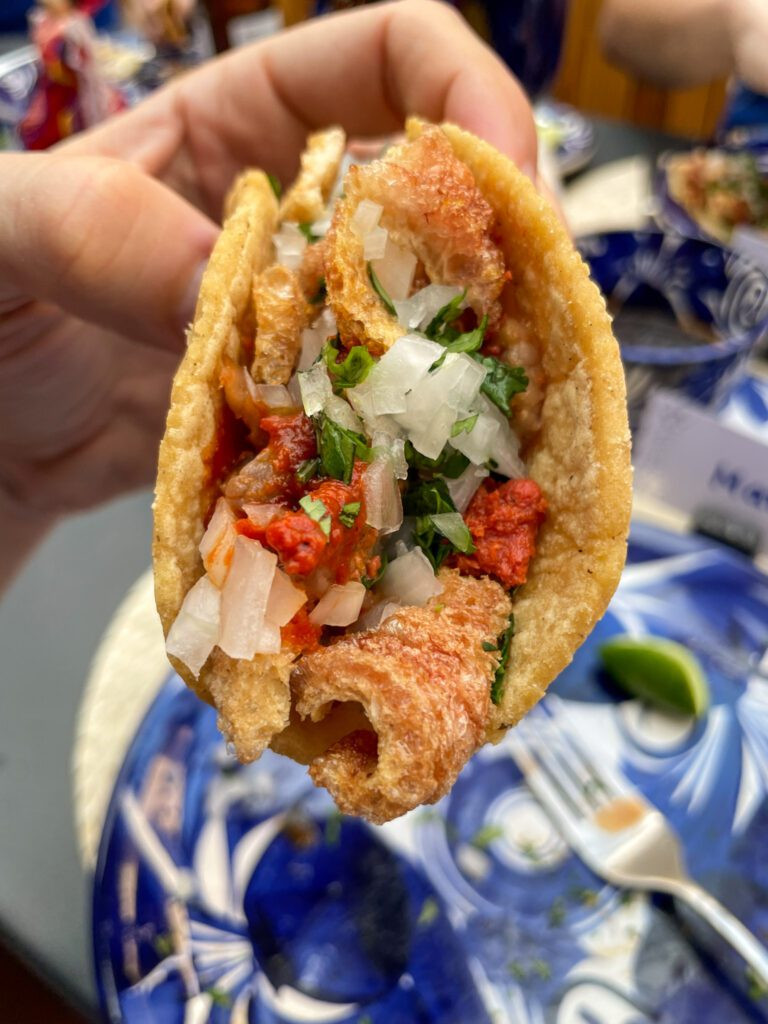 Close-up of tacos being prepared in a cooking class, showcasing the vibrant ingredients and culinary techniques.
Close-up of tacos being prepared in a cooking class, showcasing the vibrant ingredients and culinary techniques.
Aura Cocina offers various classes. I’ve personally taken and loved both their street tacos class, covering three taco types and accompanying salsas, and their four-course Mexican feast, where we prepared white mole and tlapique, dishes I was previously unfamiliar with.
If I had to choose, I’d lean towards the Mexican feast for its more unique recipes, but the tacos class is also excellent. You can’t go wrong with either.
Exploring Roma Norte
Roma Norte is one of our favorite Mexico City neighborhoods and tops our list of recommended places to stay in Mexico City.
Colonia Roma is a historic area southwest of the Centro Histórico. Unlike the more organically laid-out La Condesa, Roma Norte follows a grid pattern, reflecting its relatively modern origins.
Walking through Roma Norte, you might sense a European vibe, with wide boulevards and tree-lined streets dotted with shops, cafes, and restaurants at street level and apartments above.
There’s a reason for this: it began as an upscale suburb outside the city center, attracting wealthy aristocrats, primarily of European descent.
Since then, Roma Norte has experienced periods of decline and resurgence. In the 1980s, a downturn ultimately paved the way for its current status as one of the city’s trendiest, most desirable neighborhoods, particularly for expats and tourists.
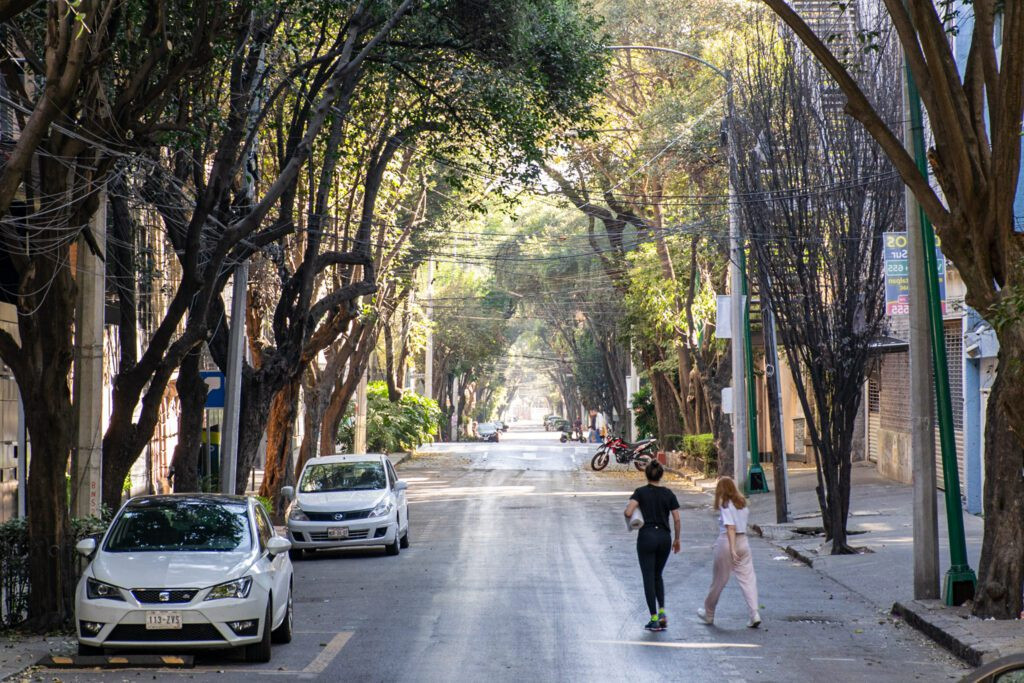 Leafy streets of Roma Norte in Mexico City, showcasing the neighborhood’s charming urban landscape.
Leafy streets of Roma Norte in Mexico City, showcasing the neighborhood’s charming urban landscape.
It’s a classic example of gentrification, a phenomenon we’ve observed in cities worldwide.
A neighborhood becomes less desirable, hence more affordable, attracting artists and bohemians who make it hip. Then, it becomes increasingly expensive, pricing out the very creative community that initially made it appealing.
A timeless cycle. It’s important to be mindful of this as you explore Roma Norte. Gentrification has driven up business and housing costs, making it increasingly unaffordable for long-term residents.
This doesn’t mean you shouldn’t visit, but be aware of gentrification’s impact and be respectful.
That said, here are our favorite spots in Roma Norte (excluding the mezcal bars mentioned on Day 1, which are also worth revisiting):
- Expendio de Maíz Sin Nombre: Possibly our favorite restaurant in Mexico City. It’s been a fantastic experience both times we’ve visited (though service was better on the first visit in 2019). This restaurant is essentially an open kitchen in a garage, serving a menu-less stream of delicious dishes based around their handmade tortillas, made with nixtamalized corn, not mass-produced corn flour. Read this excellent Culinary Backstreets article and this piece about the dying art of nixtamalization for more context. You sit down, mention any dietary restrictions, and they bring you a course. After each course, they ask if you want more. Repeat until you’re full. Most dishes are simple, but the high-quality ingredients speak volumes, creating flavor explosions.
- Pulqueria los Insurgentes: For a different, hipper pulqueria experience, this is the spot. It’s a multi-level bar with a unique vibe on each floor.
- Panadería Rosetta: The most famous bakery in Mexico City? Likely, at least among expats and tourists. Since our last visit, they’ve expanded into a larger space next door with a sidewalk patio. Pro-tip: lines are always long to eat in, so join the fast-moving line for pastries to go and enjoy them in the park around the corner (more below).
- Cardinal Casa de Café: My tied-for-best cup of coffee in the city was brewed here on a slow Sunday morning. I asked the barista/manager for a V60 recommendation, and his suggestion was perfect. Their Voltaire specialty drink, essentially a chocolate cappuccino, is also excellent.
- Tlecan: An accidental discovery on a cocktail crawl in Roma Norte/La Condesa. They offer excellent (though somewhat pricey) cocktails. Try the mezcal negroni—it’s fantastic.
- Plaza Río de Janeiro: Our favorite park in Mexico City? It’s a strong contender. With its fountain, replica of the David statue, and many dogs playing, we’ve found ourselves here multiple times across our trips. It’s always a pleasure. Grab pastries from Panaderia Rosetta and enjoy them here to escape the bakery’s sidewalk crowds. It’s located here on Google Maps.
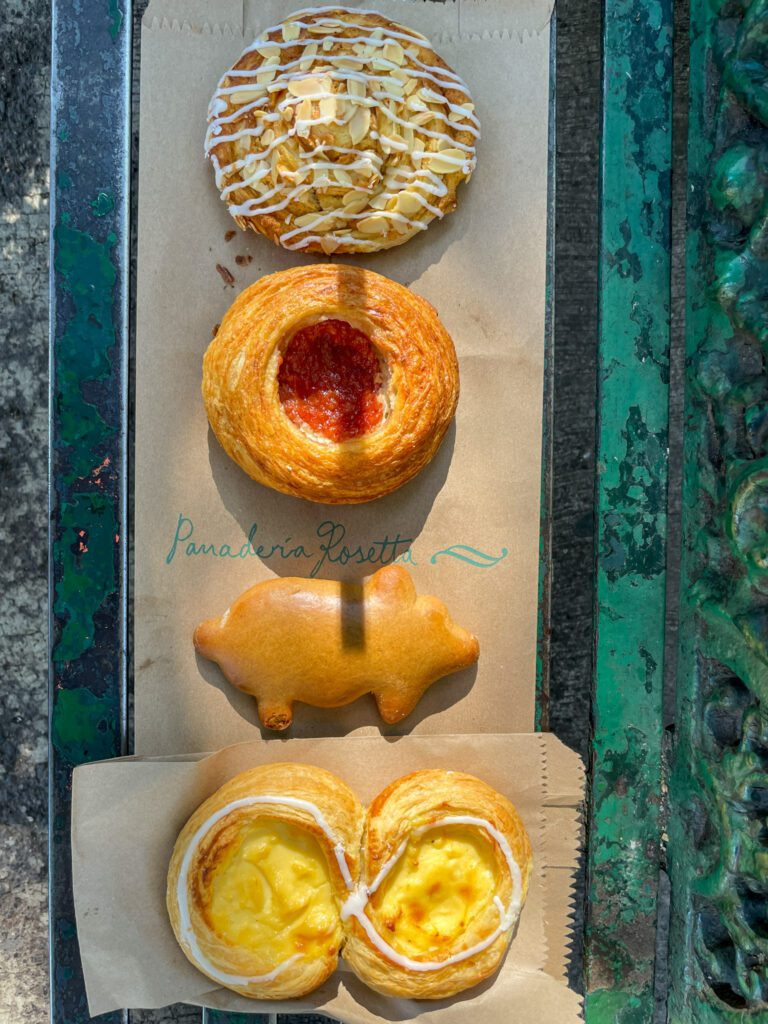 Delicious pastries from Panaderia Rosetta in Mexico City, showcasing the bakery’s renowned baked goods.
Delicious pastries from Panaderia Rosetta in Mexico City, showcasing the bakery’s renowned baked goods.
An Evening in La Condesa
La Condesa and Roma Norte share similarities. Both are upscale, leafy, and popular with tourists and expats, making them areas where you’ll hear a lot of English.
However, unlike Roma Norte’s grid layout, La Condesa is a labyrinth of tree-lined streets centered around Parque México and the smaller Parque España.
The neighborhood is sometimes called “Condesa-Hipódromo,” and a map reveals why (“Hipódromo” refers to a horse racing track). Its oval shape resembles a racetrack, a function it served until the early 20th century.
Today, La Condesa is one of Mexico City’s most affluent neighborhoods (“Condesa” means “countess,” indicative of its upscale nature) and has become increasingly popular with expats and tourists, including us.
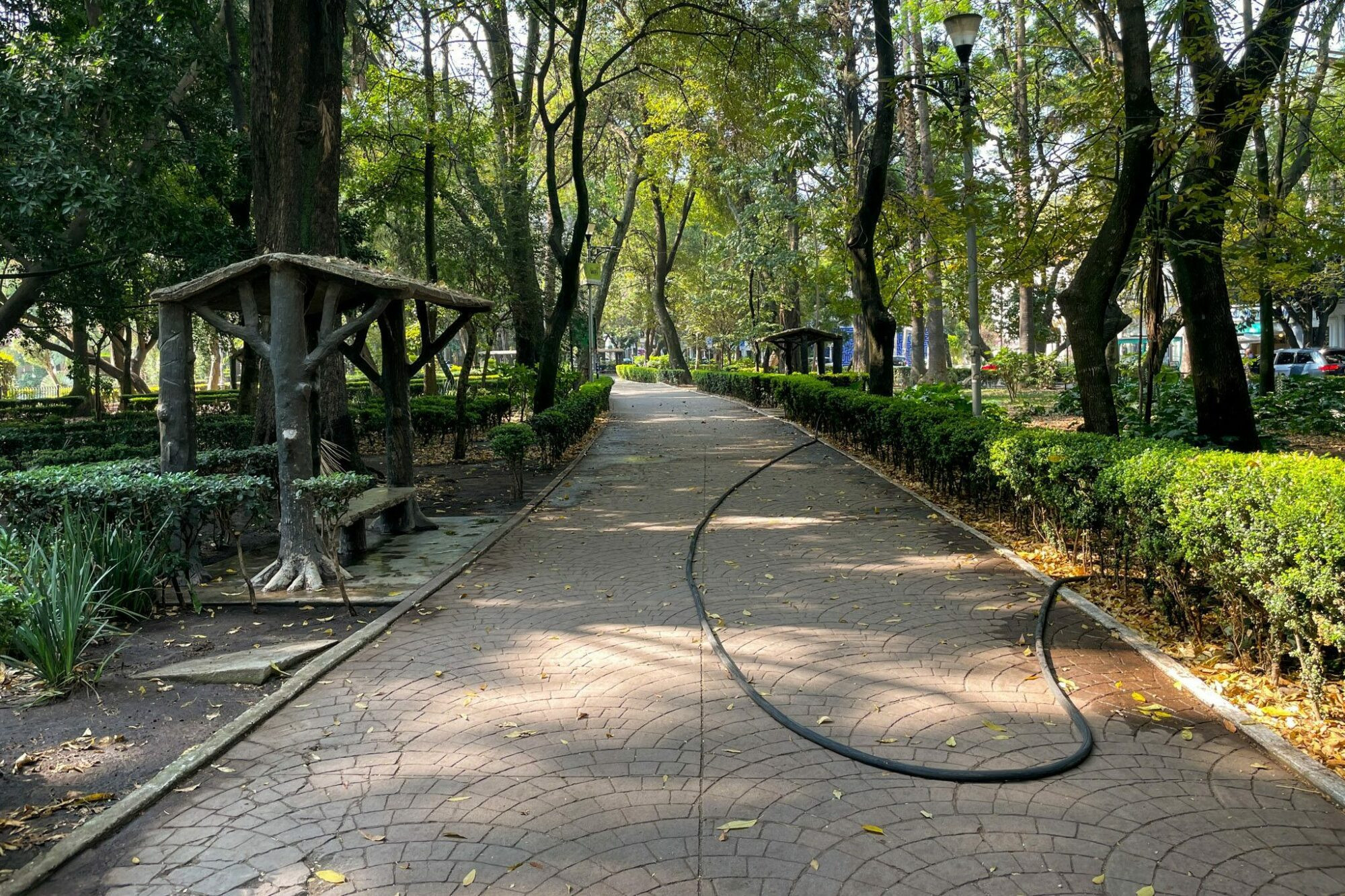 Leafy Parque México in La Condesa, showcasing the park’s greenery and relaxed urban atmosphere.
Leafy Parque México in La Condesa, showcasing the park’s greenery and relaxed urban atmosphere.
Here are our favorite spots in La Condesa, in no particular order (besides the parks, which are must-visits):
- Churrería El Moro: Touristy? Yes. English widely spoken? Yes. Worth it? Also yes. You’ve likely heard of churros con chocolate while planning your trip, and this location is our favorite place to get them. It’s busy, but grab your churros and chocolate and enjoy them across the street in the park in front of the theater. On a trip with my brothers, I sent them in to order alone, and they returned without chocolate for some reason (though they did get a churro ice cream sandwich, which they loved). Order churros and chocolate español, the thicker dipping chocolate. It’s a large cup of chocolate, unlike the Spanish version.
- Baltra Bar**: Our favorite cocktail bar in Mexico City! We’ve visited on every trip and seen it grow in popularity. On our first visit, we were one of only two couples, and had a lovely chat with the bartender. On our latest visit, we had to wait for an outside table because it was packed. The cocktails are exceptional, and all syrups and cordials are house-made.
- Pasillo de Humo: Excellent Oaxacan restaurant with tlayudas, moles, and, of course, mezcal.
- Tacos Hola: The small taco spot where we discovered the magic of tacos de guisado, which we now seek out while traveling (Guisados in L.A. and Taquería Los Puñales in Portland are favorites). Unlike tacos al pastor, tacos de guisados are filled with stews, usually meat-based. At Tacos Hola, you’ll see a counter full of clay pots with a sign explaining the contents. Highly recommended, though more of a lunch spot (requiring a return visit).
- Maizajo: I initially walked past this spot, filled with tortilla-making equipment, before doubling back, intrigued and seeking fresh tortillas for breakfast at home. Their blue corn tortillas were among our favorites in Mexico City, far superior to supermarket tortillas. They also serve prepared food, though I only bought tortillas.
- Anvil and Camino a Comala: Mentioned earlier for coffee in La Condesa before Chapultepec Park, these are our top two coffee spots in the neighborhood.
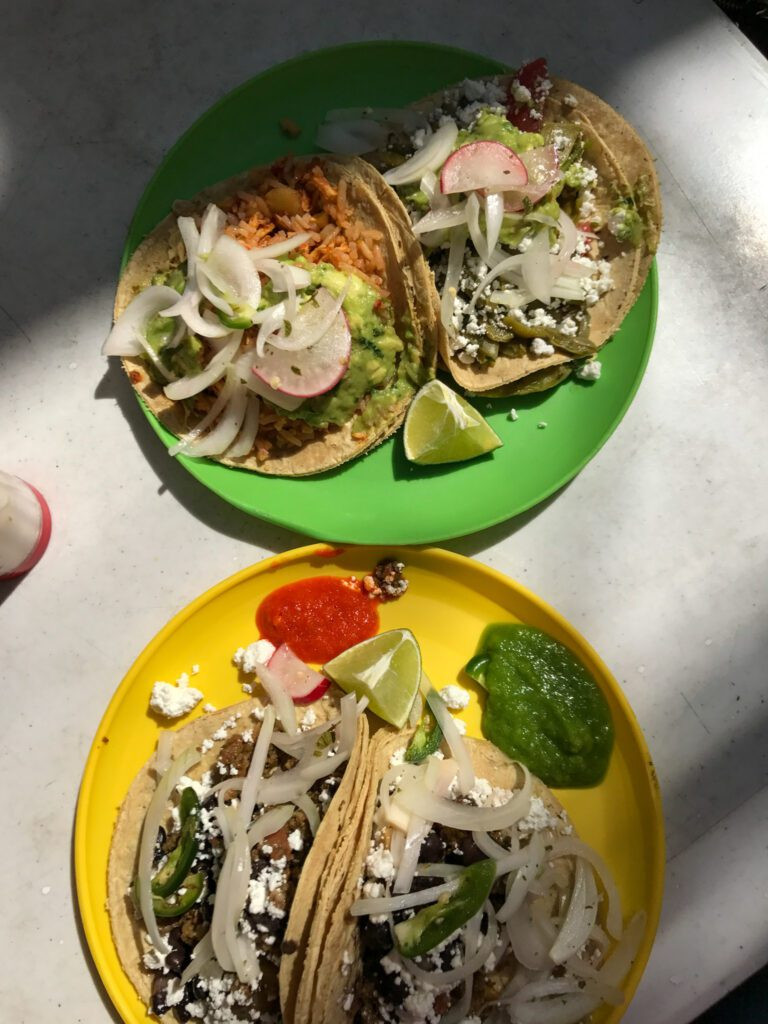 Tacos Hola in Mexico City, a popular spot for delicious tacos de guisado.
Tacos Hola in Mexico City, a popular spot for delicious tacos de guisado.
Cocktails at Baltra Bar, a Darwin-themed bar in La Condesa known for its creative and expertly crafted drinks.
Day 4: Coyoacán and Xochimilco
Your final full day explores two historic areas south of the city center: the canals of Xochimilco and Coyoacán, the former village where the Spanish first settled near Mexico City.
Exploring Mexico City’s Complex History in Xochimilco
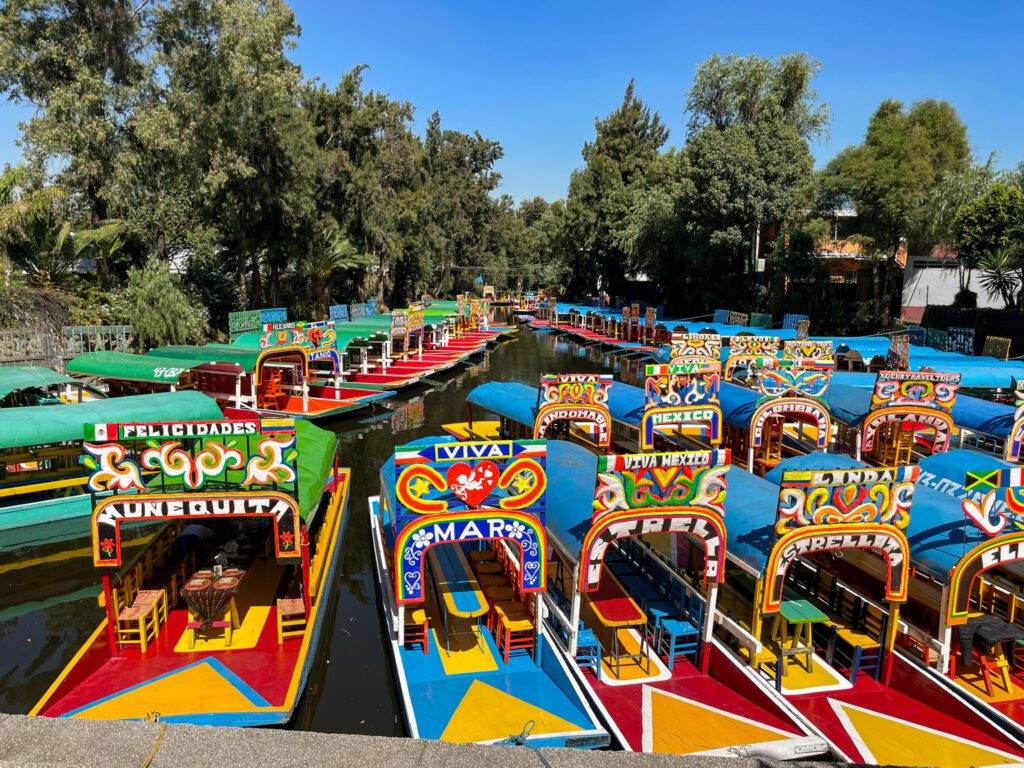 Colorful trajineras boats navigating the canals of Xochimilco in Mexico City, showcasing the area’s unique waterway system.
Colorful trajineras boats navigating the canals of Xochimilco in Mexico City, showcasing the area’s unique waterway system.
I’ll be honest (Matt here), I was very skeptical of Xochimilco. So much so that despite two previous trips (including a week-long stay), I hadn’t seriously considered visiting.
All I found were party boats with unlimited tequila and music, not really our scene.
However, after taking a tour (this one with Miroslava), I confidently recommend it. It’s worth the time (and the journey, as it’s south of the center) to understand what Mexico City was like centuries ago when the Mexicas (Aztecs) founded it.
Mexico City, as mentioned, was built on a vast lake.
The Mexicas migrated from northern Mexico or the southern US and decided a large lake in a valley surrounded by volcanoes was the ideal settlement.
For much of its history, Mexico City resembled Venice more than today’s metropolis.
The Mexicas created chinampas, man-made islands in the lake, using fertile soil for agriculture.
Around the time of European arrival, three causeways (bridges) connected the island city to the surrounding valley.
These bridges were even raised at night for security.
The Anthropology Museum has excellent maps illustrating this, a remarkable transformation.
These canals, spring-fed and central to Tenochtitlan (Aztec Mexico City), now primarily exist in Xochimilco, a residential neighborhood 30-45 minutes (traffic dependent) south of the city center.
The best way to experience them, I believe, is with a tour that provides the historical and cultural context that makes Xochimilco special.
Unfortunately, many tours focus on tequila and less on history and culture.
I extensively searched for this tour with Miroslava, a Xochimilco native who showcases her neighborhood.
Her tour blends market exploration, a cooking class, and a history/culture lesson, a three-hour journey through the neighborhood and canals.
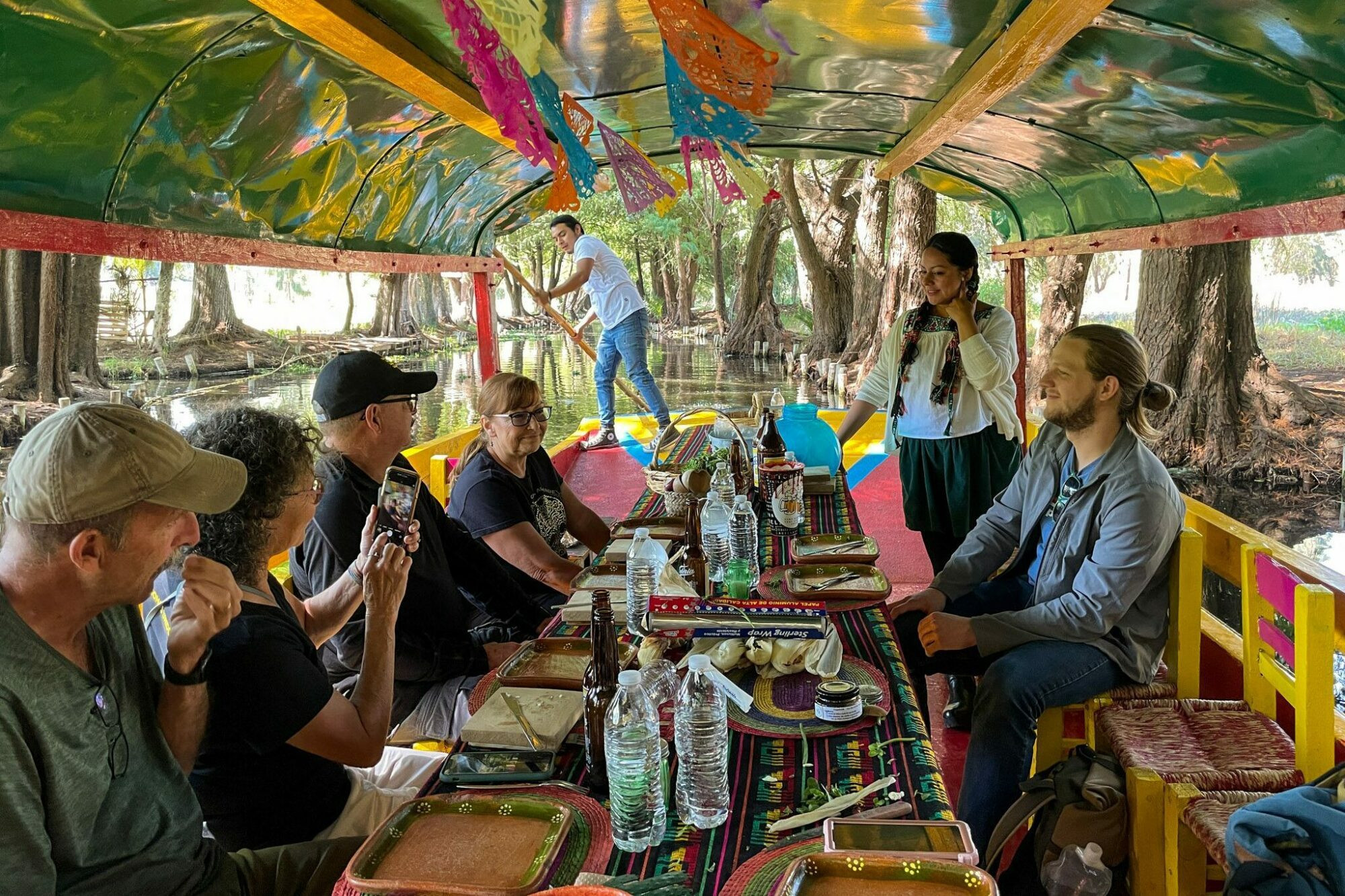 A guided tour in Xochimilco, Mexico City, offering a deeper exploration of the canals and local culture.
A guided tour in Xochimilco, Mexico City, offering a deeper exploration of the canals and local culture.
You’ll start in the neighborhood market, gathering veggies and cheese for lunch (cooked on the trajinera boat), then head to the pier and onto a boat to learn about chinampas and the endangered Axolotl salamander.
Most tours don’t include transport to/from Xochimilco (requiring Uber or a long metro ride), but Miroslava’s tour includes pickup in La Condesa, which we found valuable (though the van was a bit cramped).
Given its southern location, combining Xochimilco with Coyoacán, situated between Xochimilco and the city center, is logical.
Exploring Coyoacán and the Frida Kahlo Museum (Casa Azul)
Coyoacán is a special place. Each time I’m in Coyoacán’s main plaza—with its coyote fountain—I feel a palpable energy.
I distinctly remember my first visit, prompting the question: why don’t we have public spaces like this in the US, where people gather and socialize? It evokes the same feeling as an Italian piazza.
For us, Coyoacán’s centerpiece is Jardin Hidalgo and the Fuente de los Coyotes, embodying the neighborhood’s village-like atmosphere.
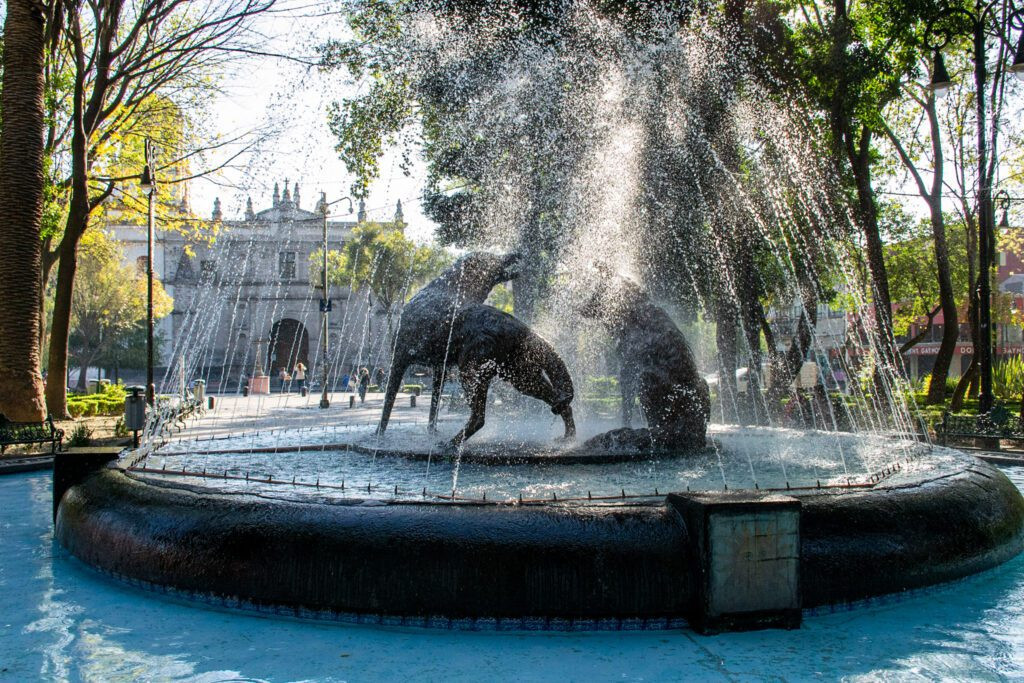 The Coyote Fountain in Coyoacán, Mexico City, a landmark symbolizing the neighborhood’s unique character and history.
The Coyote Fountain in Coyoacán, Mexico City, a landmark symbolizing the neighborhood’s unique character and history.
While part of Mexico City, Coyoacán’s cobblestone streets offer a different ambiance. Despite bustling streets, it feels like a slice of tranquility in a hectic city.
Coyoacán’s most famous attraction is Casa Azul, the Frida Kahlo Museum.
It explores the lives of Frida Kahlo and Diego Rivera, iconic artist power couple and two of Mexico’s most celebrated historical figures.
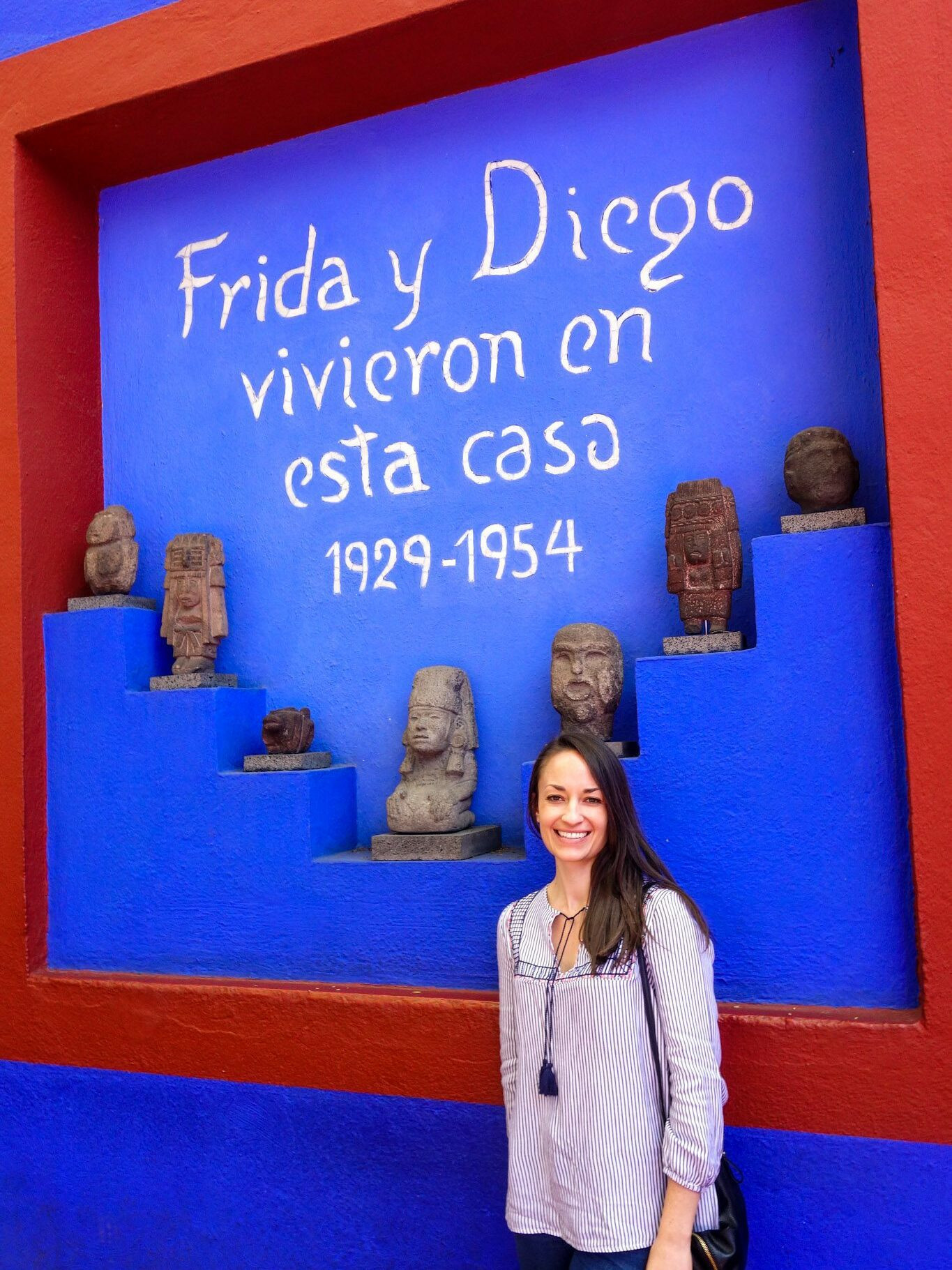 Alysha posing outside Casa Azul, Frida Kahlo’s house in Coyoacán, now a museum dedicated to her life and art.
Alysha posing outside Casa Azul, Frida Kahlo’s house in Coyoacán, now a museum dedicated to her life and art.
We visited on our first Mexico City trip, and it’s worthwhile, especially with the audio guide, which provides crucial context.
Important: It’s one of Mexico City’s most popular attractions, and space is limited. Book tickets in advance, selecting a day and time. Book here.
Note: The museum is closed on Mondays.
Since you’ll book your Xochimilco tour in advance, scheduling these together shouldn’t be difficult.
However, Casa Azul isn’t the only attraction in Coyoacán. Here are other spots to explore:
- The twin plazas: Arguably Coyoacán’s highlight, Jardín Hidalgo and Jardín Centenario (and Fuente de los Coyotes) are the neighborhood’s heart and soul. The energy here is palpable at any hour.
- Cafe Avellaneda: A must-visit for coffee lovers. This tiny café on a cobblestone side street serves my favorite Mexican coffee roaster, Jiribilla (same owners). Filter coffee, espresso drinks, and specialty drinks, including an excellent espresso tonic, are available.
- Mercado de Coyoacán: A great example of a Mexico City market, slightly less chaotic than Centro markets. It’s a mix of produce, food stalls, crafts, and restaurants. The tostada stands, especially the large one with yellow walls and orange lettering, are worth a stop.
- Centro Cultural Elena Garro: Part bookstore, part community center. Worth visiting for its architecture alone.
 A colorful Coyoacán sign in Mexico City, welcoming visitors to the charming and historic neighborhood.
A colorful Coyoacán sign in Mexico City, welcoming visitors to the charming and historic neighborhood.
What to Do with More Time in Mexico City
Here are additions for a longer Mexico City trip:
Teotihuacan
You’ve likely heard of the massive pyramids of Teotihuacan.
Like the Colosseum or other ancient ruins, a guided tour is recommended, especially considering transportation—most tours include transport to the archaeological site, about 45 minutes outside the city.
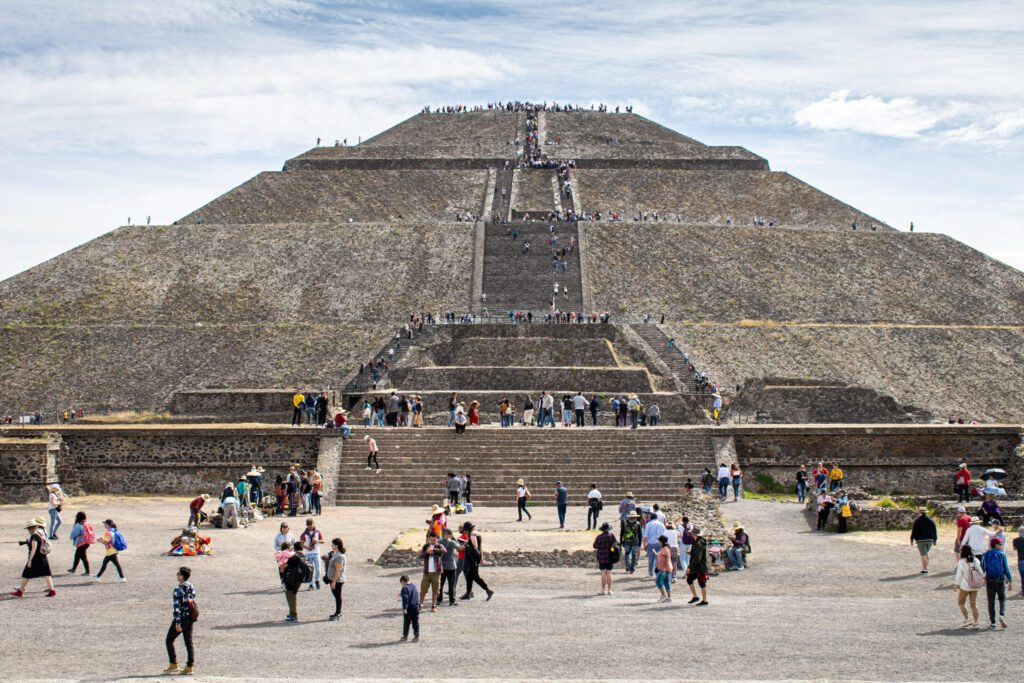 The majestic pyramids of Teotihuacan, an ancient Mesoamerican city near Mexico City, showcasing its historical scale.
The majestic pyramids of Teotihuacan, an ancient Mesoamerican city near Mexico City, showcasing its historical scale.
A knowledgeable guide enriches the experience.
We took this tour, including transport, Teotihuacan tour, lunch, and an extra stop.
It was enjoyable, but a bit long, especially the post-Teotihuacan parts. For shorter trips, consider a different tour. It’s a full-day commitment.
Tips for visiting: The site is exposed, with limited shade. Bring a hat, long sleeves, and sunscreen.
Take a Street Food Tour
Another excellent experience is a street food tour (we prioritized the cooking class in the main itinerary).
Street food tours are perfect for experiencing Mexico City’s vibrant street food culture.
Some of our best Mexico City food memories involve street food, especially blue corn quesadillas with squash blossoms and tamales dulces (pink tamales).
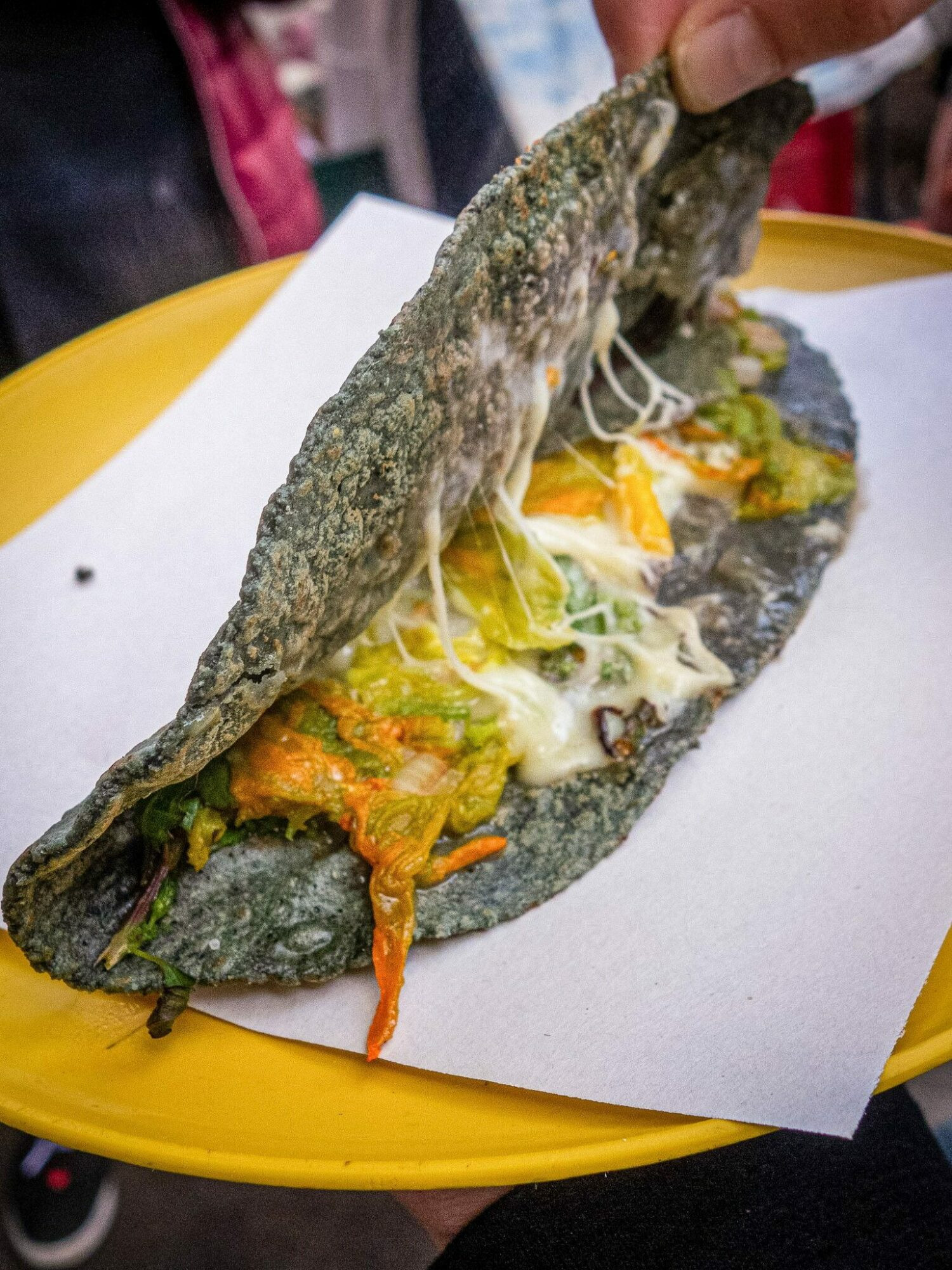 An incredibly delicious blue corn quesadilla, highlighting Mexico City’s street food culinary delights.
An incredibly delicious blue corn quesadilla, highlighting Mexico City’s street food culinary delights.
Navigating the vast street food scene can be daunting.
As always, we recommend engaging locals for deeper insights. Guided tours provide richer cultural understanding.
You’ll gain knowledge of Mexican food culture (and broader culture) from a 3-4 hour tour with a local guide and fellow travelers.
We have personal experience with this.
We recommend companies that are local and ethical in their vendor relationships.
One company we’ve toured with is Club Tengo Hambre’s Street Food Essentials Tour, a loop starting at Palacio Bellas Artes, featuring 7-8 food stops over several hours, leaving you very full.
They also offer Condesa and Merced Market tours.
Another recommended company is Eat Like a Local. Their model prioritizes fair wages, local businesses, and authentic traveler experiences.
Read about them and their founder here.
Their flagship Mexican Food 101 tour is ideal for first-timers, including a market tour, flower market, and numerous food stops.
A third option is this street food + bike tour, covering more ground in a large city like Mexico City.
What to Do with Less Time in Mexico City
For shorter trips (two or three days), here’s how to adapt the itinerary:
With Three Days
For three days, cut Xochimilco, mainly due to its distance. Focus your time elsewhere.
Anchor your days around key experiences: walking tour, cooking class, and Anthropology Museum.
Integrating Coyoacán, a must-see, is key.
Visit Coyoacán on the morning of your Anthropology Museum tour, potentially skipping the National History Museum to manage time.
It’ll be a packed day, but the best way to organize it. Otherwise, follow the itinerary as written.
With Two Days
Honestly, two days in Mexico City isn’t enough to fully appreciate this vast city.
However, if that’s all you have, here’s how to maximize it.
Day one: Follow Day 1 of the itinerary as is.
The walking tour is crucial for foundational city knowledge, people, and history, enriching your entire experience.
Day two: Morning in Coyoacán—Cafe Avellaneda, the plazas, coyote fountain, and Casa Azul (Frida Kahlo’s House).
Afternoon: Explore Roma Norte and La Condesa. Panaderia Rosetta pastries, Cardinal coffee, Expendio de Maíz lunch, and park time in La Condesa. Cocktails at Baltra and churros at El Moro are also essential.
It’s a fast-paced two days, but worthwhile.
